RapidEye Earth Observation Constellation
EO
Atmosphere
Cloud type, amount and cloud top temperature
Cloud cover
Launched in August 2008 and deactivated in March 2020, the RapidEye Earth observation system was a commercial constellation of five minisatellites, owned and operated by BlackBridge, a Berlin-based geospatial information provider acquired by Planet Labs in 2015. RapidEye provided high resolution multispectral imagery with the aim of generating unique land information products.
Quick facts
Overview
| Mission type | EO |
| Agency | DLR |
| Mission status | Mission complete |
| Launch date | 29 Aug 2008 |
| End of life date | 30 Apr 2020 |
| Measurement domain | Atmosphere, Land, Snow & Ice |
| Measurement category | Cloud type, amount and cloud top temperature, Multi-purpose imagery (land), Vegetation, Albedo and reflectance, Sea ice cover, edge and thickness, Snow cover, edge and depth |
| Measurement detailed | Cloud cover, Land surface imagery, Vegetation type, Earth surface albedo, Land cover, Sea-ice cover, Snow cover, Glacier cover |
| Instruments | MSI |
| Instrument type | High resolution optical imagers |
| CEOS EO Handbook | See RapidEye Earth Observation Constellation summary |
Related Resources
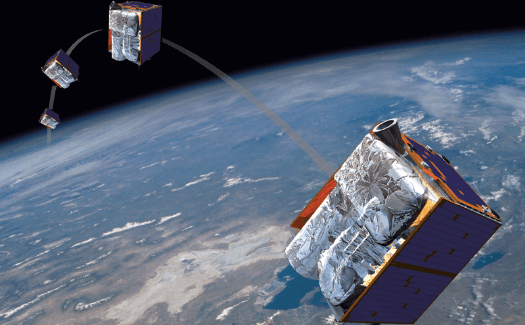
Summary
Mission Capabilities
Each RapidEye minisatellite carried a single instrument, REIS (RapidEye Earth Imaging System) , a five channel VNIR (Very Near Infrared) radiometer. REIS produced high resolution multispectral imagery with applications in agriculture, environment, forestry, mapping, intelligence and defence.
Performance Specifications
Across its five channels (blue, green, red, red edge, near infrared), REIS had spectral coverage of 440 - 850 nm.REIS used a pushbroom scanning technique, with an IFOV (Instant Field of View) or spatial resolution of 6.5 m, and a FOV (Field of View) of ± 6.75° about nadir, which corresponds to a swath of more than 70 km at an orbital altitude of 622 km.
The RapidEye constellation operated in a sun-synchronous orbit of altitude 622 km and inclination 98.7°, with the five minisatellites evenly spaced along a single orbital plane. The constellation had an orbital period of 97 minutes, and a repeat cycle of one day.
Space and Hardware Components
The RapidEye constellation used a minisatellite bus developed by SSTL (Surrey Satellite Technology Ltd.), known as MicroSat-150, or SSTL-150. The bus had a launch mass of 156 kg, and dimensions 0.78 m x 0.938 m x 1.17 m. The AOCS (Attitude and Orbit Control Subsystem) consisted of four reaction wheels, enabling three-axis control, in addition to a Xenon propulsion system and attitude sensing provided by redundant star sensors and magnetometers. The spacecraft had 48 Gbit of onboard storage capacity with data downlink transmitted in X-band, with a data rate of 80 Mbit/s, and TT&C (Tracking, Telemetry and Control) transmission in S-band with a 9.6 kbit/s uplink data rate, and a 38.4 kbit/s downlink data rate.
RapidEye Earth Observation Constellation
Spacecraft Launch Mission Status Sensor Complement Ground Segment References
RapidEye is a full end-to-end commercial Earth Observation system comprising a constellation of five minisatellites, a dedicated SCC (Spacecraft Control Center), a data downlink ground station service, and a full ground segment designed to plan, acquire and process up to 5 million km2 of imagery every day to generate unique land information products.
The system is owned and operated by BlackBridge. MDA (MacDonald, Dettwiler and Associates Ltd) was the mission prime contractor and was responsible for the delivery of the space and ground segments, launch of the constellation, and on-orbit commissioning and camera calibration. The two major subcontractors to MDA were SSTL (Surrey Satellite Technology Ltd.) for the spacecraft bus, SCC and spacecraft AIT (Assembly, Integration and Test) services, as well as Jena Optronik GmbH (JOP) who provided the 5-band multispectral imager (RGB, red edge, and near IR bands).
The RapidEye constellation represents a major milestone in the Earth observation industry. It is the first fully commercial operational class Earth observation system using a constellation of 5 satellites that provides unparalleled performance. 1) 2)
The main objective is to provide a range of Earth-observation products and services to a global user community. The main vertical markets BlackBridge serves are: 3) 4) 5) 6) 7) 8) 9) 10) 11)
• Agriculture
• Environment
• Forestry
• Mapping
• Intelligence and Defense
• Security & Emergency
• Visual Simulation.
No of satellites | 5 |
FOR (Field of Regard) | ±20º in cross‐track |
Optical payload | Multispectral pushbroom imager |
Downlink of imagery | 80 Mbit/s (X-band) |
GSD at nadir | ~6.5 m |
Swath width | 77 km |
Imager CCD detector | Linear array, 12 k pixel |
Global revisit time | 1 day (with body-pointing capability) |
Onboard data storage | 48 Gbit, (1,200 km of imagery/orbit) |
Optical bands, | 5, (400-850 nm) |
Data quantization | 12 bit |
Spacecraft pointing capability | Agile spacecraft with 3-axis control, |
Spacecraft launch mass | ~156 kg |
Mission design life | > 7 years |
Orbit | Nominal circular SSO, 630 km altitude, 11:00 hours equator crossing time on descending node |
Background: The RapidEye business concept was initiated in 1996 by Kayser-Threde GmbH of Munich with support from the German Space Agency (DLR). The overall goal was to provide end-to-end solutions to clients whose geospatial information needs require large-area coverage, repetitive monitoring and frequent revisits. RapidEye was established as an independent company in December 1998 once the concept had matured enough to receive seed financing from the German Space Agency (DLR) and Vereinigte Hagelversicherung (VH), the largest German agro-insurance company, as well as a few private investors.
In September 2002, RapidEye (known as BlackBridge since November 2013) and MDA of Richmond, BC, Canada, signed a partnership agreement. In this arrangement, MDA is the general contractor for the mission, responsible for the implementation of the space and ground segments, launch and in-orbit commissioning and calibration. 12) 13)
Change of RapidEye constellation ownership in August 2011 14) 15)
The Canadian distributor of optical satellite imagery, Iunctus Geomatics Corp., announced on Sept. 1, 2011 that it had acquired the assets of RapidEye AG of Brandenburg an der Havel, Germany, a global provider of high-resolution imagery and geospatial solutions. The purchase was finalized on Monday, August 29, 2011 in Potsdam, Germany. The new company is called RapidEye Canada Ltd. 14) 15)
Note: RapidEye Canada Ltd. is an affiliate of BlackBridge Corporation, a group of companies in geospatial imagery with business partners in over 70 countries.
Iunctus Geomatics Corp. of Lethbridge, Alberta, whose current business includes being Canada's exclusive distributor of French SPOT optical satellite data, provides a wide range of geomatics products and services for its clients, including satellite data, value added imagery, data management/hosting and satellite tasking. - RapidEye AG has taken over operation of the five identical 150 kg RapidEye satellites, which have been in orbit since August 2008. RapidEye AG will continue to operate as an independent company, leveraging a new strong German management team in order to maintain its successful brand and relationships.
RapidEye images over 4 million km2 of Earth's surface every day, and has amassed over 2 billion km2 in its archive in just over two years of commercial operation The 5 satellites of the constellation are healthy in orbit, and current estimates are that they could remain fully operational until 2018. Given the production and launch cycles for satellites such as this, RapidEye's new owners likely will need to decide on a successor constellation in 2014, giving them more than two years to evaluate the size of the business.
• On November 6, 2013, the former RapidEye unit of Berlin, Germany, has officially changed its name to BlackBridge. This change is the result of a two-year process of uniting all BlackBridge owned companies as one presence in the marketplace. It will empower the BlackBridge group to harness its combined resources to offer its partners and customers end-to-end solutions across the entire geospatial value chain at a global level. 16)
• In July 2015, Planet Labs Inc., a San Francisco-based provider of imagery and operator of the Flock-1 nanosatelliteEarth imaging constellation, announced an agreement with BlackBridge to purchase the BlackBridge geospatial companies, including the RapidEye suite of core offerings. Will Marshall, Planet Labs' CEO, strongly believes that "Planet & BlackBridge have great mission alignment and offer complementary capabilities. BlackBridge brings a significant, global book of business, and a substantial 5 meter data archive from which to monitor global change. We're excited to fold their talented team, data collection, and deep industry roots into our rapidly growing operation." 17) 18)
For BlackBridge, this is the next step to explore the earth to empower decisions, which aligns perfectly with Planet Labs' mission. For years, BlackBridge has served customers across a broad range of domains, but has fundamentally focused on agriculture, energy & infrastructure, consumer mapping, government, business intelligence, environmental & social impact. The result of this union with Planet Labs is expected to increase the value BlackBridge provides to existing customers and provide the means to expand into new domains. - The company is expected to operate largely as it does today. It is anticipated that customers will continue to experience the exceptional service they've come to expect from BlackBridge and will soon see the benefits of this new alliance.
The transaction is subject to the customary closing conditions and is expected to close during the third quarter of 2015.
Space Segment
The satellite platforms (MicroSat-150 - also referred to as SSTL-150) are being developed and built by SSTL (Surrey Satellite Technology Ltd., Guildford, Surrey, UK) based on the enhanced platform, used for the following remote sensing missions: TopSat, Beijing-1 (both of which were launched on Oct. 27, 2005). Each RapidEye spacecraft is three-axis stabilized, featuring a box-like shape of approximate dimensions: 0.78 m x 0.938 m x 1.17 m. The overall design has the S/C divided into three separate functional volumes. At the base of the S/C is the launch vehicle separation system which is baselined as a four-point release system with integral deployment springs along with some attitude sensors. In the mid-deck are the majority of the bus subsystems and the PEU (Payload Electronics Unit), while the optical imager and the star camera are located at the top end of the spacecraft.
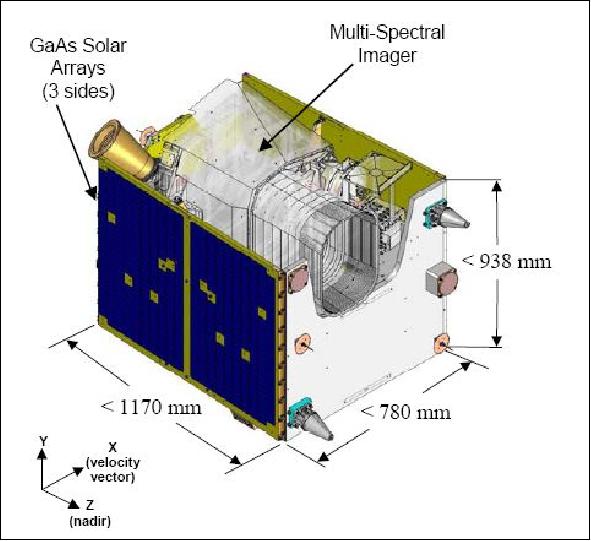
The SSTL-150 bus is built around a "stack" of core avionics modules (e.g. computers and data recorders) contained in microtrays, and providing mechanical strength. This supports other components of the spacecraft. Attached to the stack are further small panels which provide extra support for the payload panel and the separation panel. The battery is mounted on the stack, between small panels, which also support the star tracker electronics modules (Ref. 2).
The S/C launch mass is ~ 156 kg, of which 12 kg is propellant and 43 kg is the optical payload.
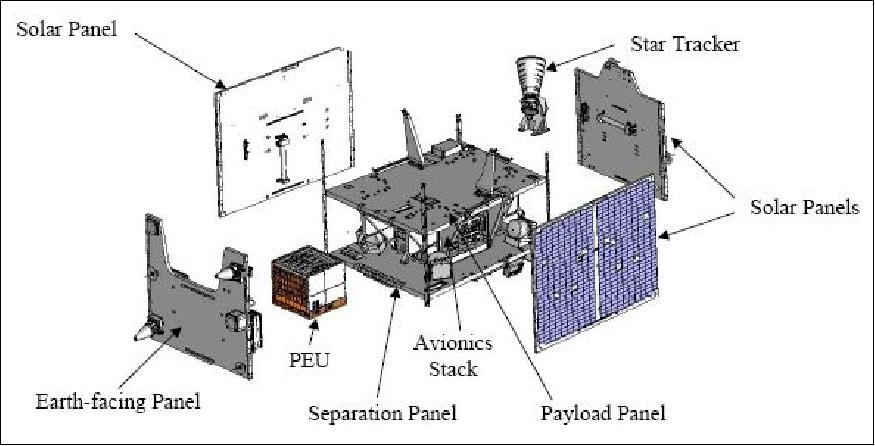
The spacecraft architecture and its various subsystems are shown in Figure 9.
• The electric power subsystem consists of three GaAs solar panels located on the +x, -z, and -x faces of the S/C. The solar panels are based on single junction GaAs/GE cells. The +x and –x panels are larger and have a nominal maximum power of 110 W; the smaller –z panel has a nominal power of 55 W. The orbit average power generated by the panels is 64 W at BOL (Beginning of Life). A 15 Ah Li-ion battery (from ABSL, UK) is used consisting of BCRs (Battery Charge Regulators).
• Power is supplied from the battery to the redundant PCM/PDM units. These have the following functions:
• PCM (Power Conditioning Module): conversion of the unregulated supply from the battery to a regulated 5 V supply
• PDM (Power Distribution Module): switching of both the 28 V unregulated battery supply and the regulated 5 V supply to spacecraft subsystems.
• The AOCS (Attitude and Orbit Control Subsystem) relies on four reaction wheels for three-axis control with redundant magnetic torques (dual-wound) for momentum management. In addition, there is a xenon propulsion system. Attitude sensing is provided by redundant sun sensors and magnetometers (coarse attitude knowledge); in addition a redundant star camera is providing high-accuracy attitude information (model: Altair HB star tracker developed by SSTL; heritage of BilSat-1 and Beijing-1). The star camera is mounted directly to the payload optical bench to minimize alignment errors (FOV of 15.74º x 10.53º).
The spacecraft uses a redundant GPS receiver for orbit determination and on-board time provision. A body-pointing capability in the roll axis of the spacecraft exists which permits a ±20º FOR (Field of Regard) for camera observations into any direction. Data gathering and processing is provided by the ADCS (Attitude Determination and Control Subsystem) which is running on the OBC. The ADCS modules interface between the CAN bus and analog sensors and actuators.

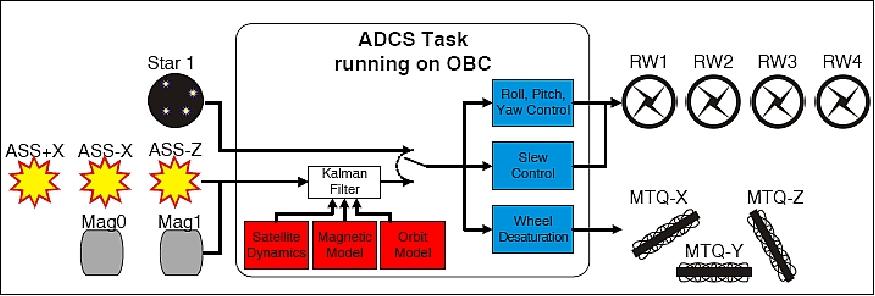

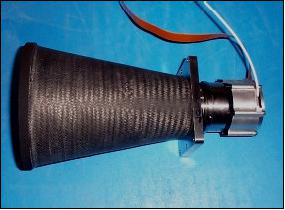
• The propulsion subsystem is based on a warm gas blow down system utilizing a Xenon resistojet thruster with a single propellant tank and associated plumbing. The primary mission applications envisaged for the low-power resistojet are: a) drag compensation, and b) constellation orbit phasing (each satellite relative to rest of constellation). The resistojet provides an Isp in the 50-100 s range, a thrust of 10-100 mN, and is capable of imparting a ΔV of up to 35 m/s (for a S/C mass of 150 kg). A maximum of 12 kg gaseous Xe at 70 bar can be filled into the spherical tank (volume of 7.4 liter). The propulsion unit may require up to 30 W from the platform power system. The onboard propulsion system is being used for constellation maintenance. 19)
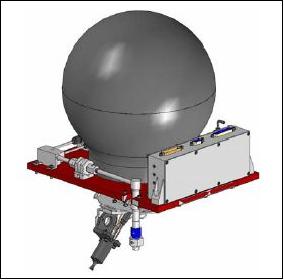
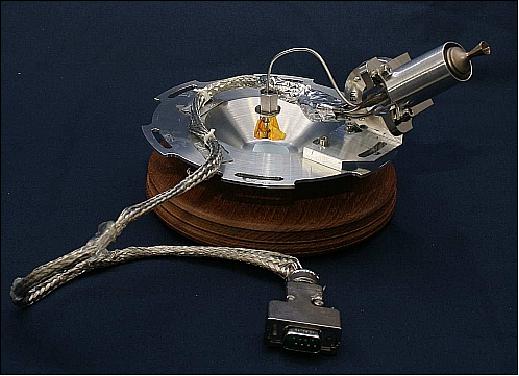
• Onboard data handling (OBDH) and monitoring functions are provided by redundant OBCs (OBC 386). A dual-redundant CAN (Control Area Network) bus provides communication between all subsystems and the OBC, including the payload. The CAN platform is a resilient high-speed serial platform which runs at 388 kbit/s. A real-time operating system is used to support SSTL's custom spacecraft software which controls and monitors all the on-board systems.
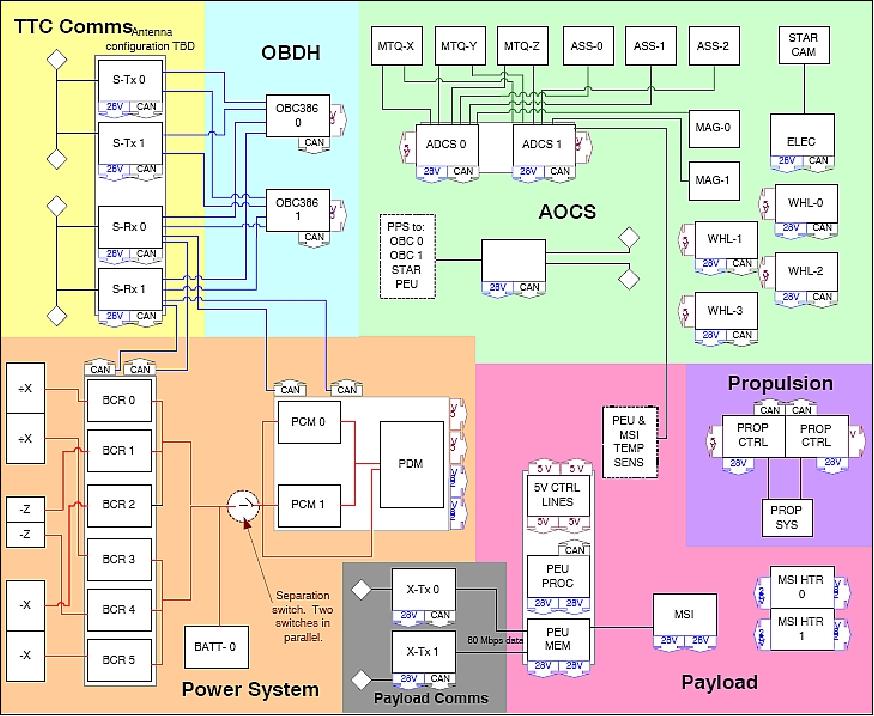
• RF communications: The onboard storage capacity of imagery is 48 Gbit. RF communication of imagery is provided in X-band (8.25-8.40 GHz), while TT&C communications are in S-band. The S-band system consists of: 2 uplink receivers (9.6 kbit/s), 2 patch antennas, 2 downlink transmitters (38.4 kbit/s), and 2 monopole antennas (downlink), modulation of QPSK.
The X-band downlink has a payload data rate of 80 Mbit/s. The data downlink uses commercial data receive stations operating in the X-band. The mission control center is located at BlackBridge headquarters, Berlin, Germany. - Each RapidEye spacecraft employs a new compact X-band antenna design of SES (Saab Ericsson Space) as shown in Figure 10. The X-band transmitters are controlled and monitored via the CAN platform. The X-band antennas use a helical radiating element that provides a wide gain pattern with a peak gain around 70º off the antenna bore sight to allow for downlinking with large roll angles in either direction.
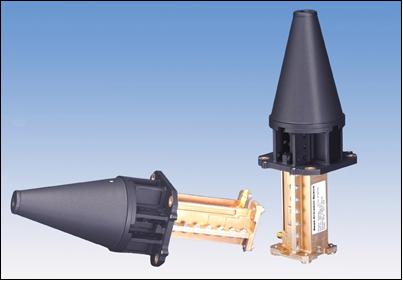
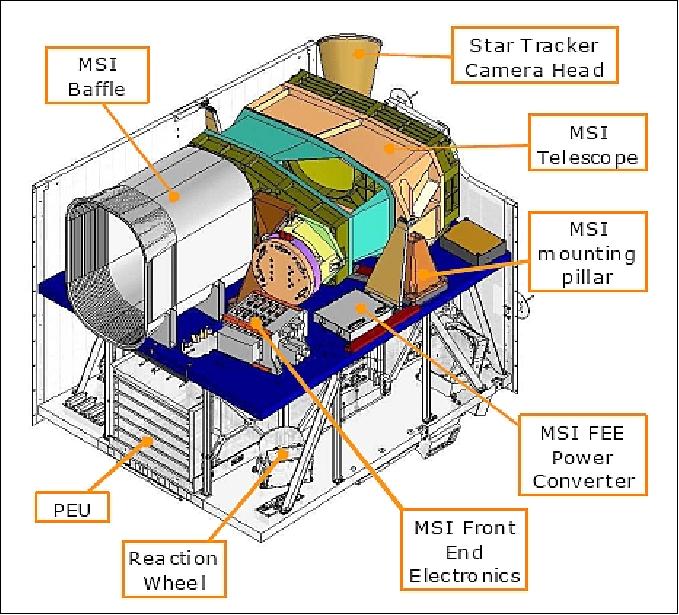
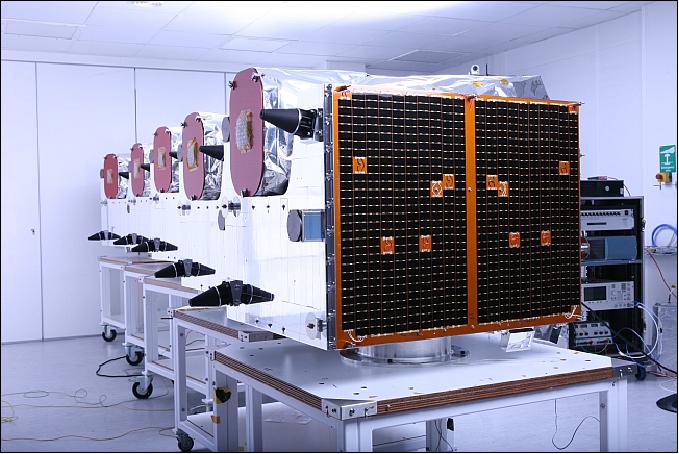
Launch: A single launch of the RapidEye minisatellite constellation on a Dnepr launch vehicle took place on August 29, 2008. The launch provider was ISC (International Space Company) Kosmotras; the launch site was the Baikonur Cosmodrome, Kazakhstan. Fifteen minutes after liftoff, the tracking station in Oman received confirmation that all 5 satellites had been released from the rocket fairing on schedule. All spacecraft were being placed into slightly different orbits to allow constellation phasing. 20)
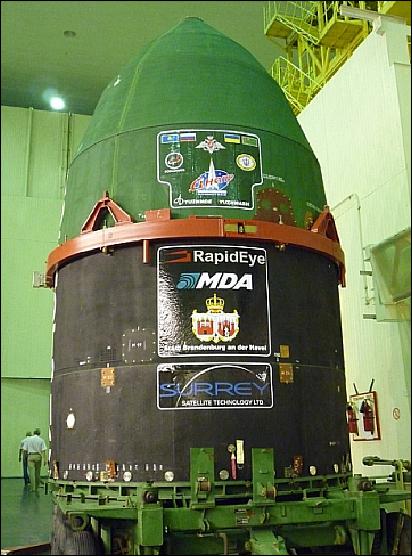
Orbit: Sun-synchronous orbit (all five satellites are evenly spaced in a single orbital plane), altitude = 630 km , inclination = 97.9º, local equator crossing time at 11:00 hours (± 1 hour) on the descending node (LTDN), period = 96.7 min, revolutions/day = 14.89, spacing/orbit = 24.202º.
The S/C follow each other in their orbital plane at about 19 minute intervals. The constellation approach in a single orbital plane permits a cumulative swath to be built up (the spacecraft view adjacent regions of the ground, with image capture times separated by only a few minutes). A revisit time of one day can be obtained anywhere in the world (±84º latitude) with body pointing techniques. The average coverage repeat period over mid-latitude regions (e.g., Europe and North America) is 5.5 days at nadir.
The RapidEye constellation requires its constituent spacecraft to be at the same altitude and phased around the orbit in order to meet the imaging requirements. To achieve this, SSTL has implemented a CMS (Constellation Management System) based on previous work on the DMC (Disaster Monitoring Constellation). The CMS supports the analysis of orbit data and planning of orbit correction maneuvers, and has a simple and robust user interface. It also provides orbit data which may be used for simple visualization of the state of the constellation (Ref. 1).
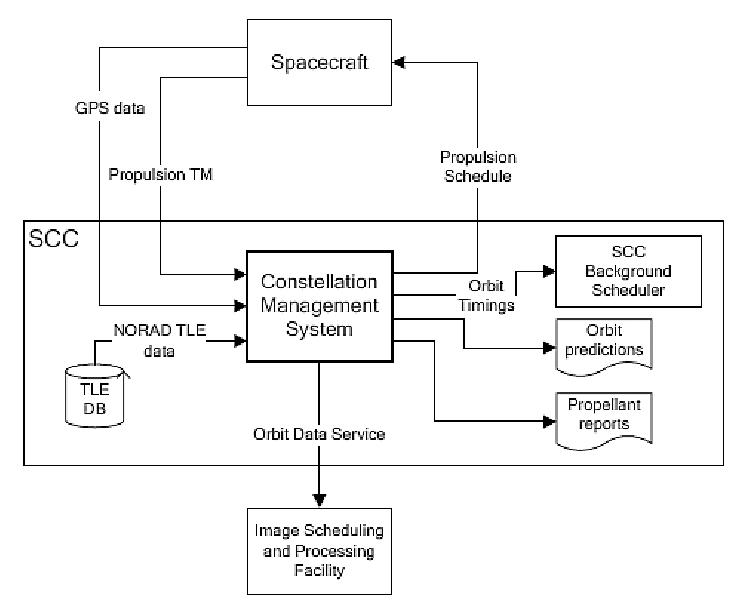
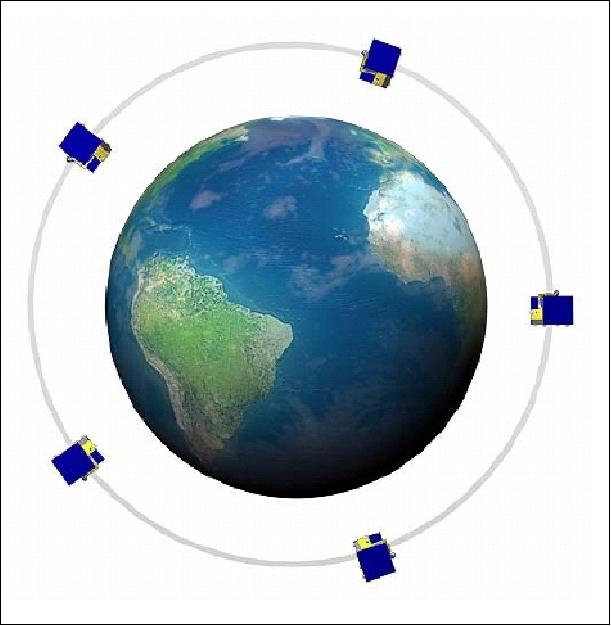
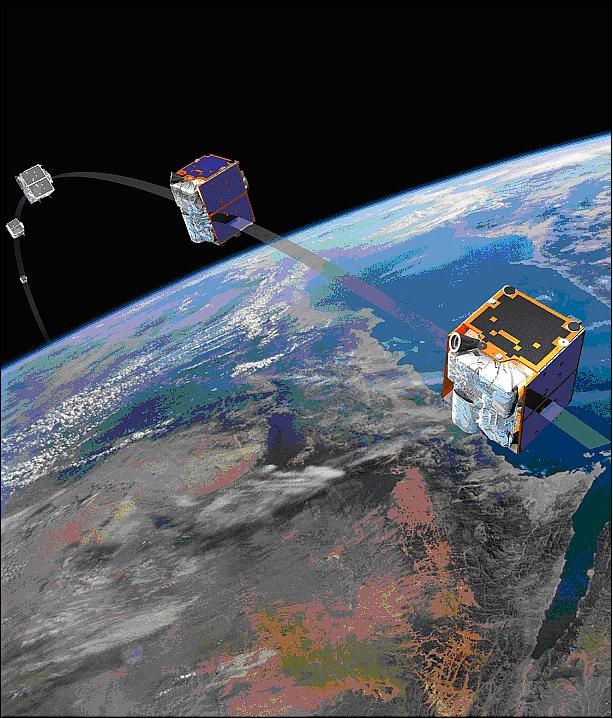
Mission Status
• January 24, 2020: After 11 years in operation, surpassing a design lifetime of 7 years, the RapidEye constellation will be retired in March 2020. 21)
- The satellite operator, Planet, has chosen to retire the five satellites proactively and facilitate a transition from RapidEye imagery to the Next-Generation PlanetScope products, which provide higher spatial resolution as well as continuity with the Red, Green, Blue, Near Infrared and Red-Edge bands provided by RapidEye.
- Thanks to ESA's Earthnet Third Party Missions program, RapidEye imagery has supported an incredibly large number of research and development projects in Europe and around the world. Planet remains the steward of RapidEye's vast archive of imagery which consists of more than 15 billion km2 that will continue to be available to European researchers.
- Recently, the Earthnet program initiated the assessment of very high resolution data acquired by the 15-satellite SkySat and over 120-satellite PlanetScope constellations. A dedicated announcement of opportunity will be issued by ESA in the coming weeks to allow researchers to test the suitability of this data for science and applications.
- RapidEye data has also been used in the framework of the Copernicus Data WareHouse as a Contributing Mission since its launch in 2008. The data contributed to covering parts of Europe and they have proved instrumental for a wide number of Copernicus activities. The RapidEye mission will be available for new rush tasking (e.g. in support to the Copernicus Emergency and Security Services) until 28 February, for tasking orders to be fulfilled until 31 March.
- Meanwhile, Planet is currently finalizing the interfaces to the Copernicus Data WareHouse that will allow the seamless integration of the SkySat and PlanetScope constellations. A dedicated announcement will follow about the availability of these missions.
• January 16, 2020: It's with mixed sentiments that we share that Planet's RapidEye constellation will be retired at the end of March 2020. After 11 years of faithfully gathering imagery, it has aged gracefully, to say the least. 22)
- RapidEye has gone above and beyond, making invaluable contributions to our global Earth observation dataset since being acquired from BlackBridge in 2015. The constellation has been in operation nearly four years longer than its design life and has generated the largest global archive of five meter satellite imagery to date.
- Having surpassed its mission, and in accordance with Planet's satellite operating license, we have chosen to retire the satellites proactively, staying committed to space exploration best practices and space debris regulations.
- Since being launched into sun-synchronous orbit aboard the Dnepr rocket in Kazakhstan in 2008, the five RapidEye satellites have:
a) Orbited the Earth more than 305,000 times
b) Traveled a distance of nearly 13,422,000,000 kilometers, which is over 89 times the distance between the Earth and the Sun
c) Taken more than 660,000 pictures of Earth's total landmass, which is equal to more than 15 billion km2 of imagery data.
- RapidEye satellites will no longer collect imagery for commercial or noncommercial use, but their contributions to Earth observation will always remain in our digital memories. Planet remains the steward of RapidEye's vast archive of impressive imagery, which customers will continue to leverage.
- With support from our teams, customers who use RapidEye imagery will transition to our Next-Generation PlanetScope products, which provide higher spatial resolution as well as continuity with the Red, Green, Blue, Near Infrared and Red-Edge bands.
- While there are no plans to build a second generation of RapidEye satellites, Planet forecasts that our Next-Generation PlanetScope product will meet, or exceed, RapidEye's historical coverage of Earth's landmass. We also will continue to invest in future iterations of Dove satellites, creating significant enhancements to our medium-resolution PlanetScope imagery.
- RapidEye has been a vital contributor to Planet's mission of making change visible, accessible and actionable. Though the satellites remained active for just over a decade, their impact on the field of aerospace will be remembered for many a lifetime.
A Collection of RapidEye's Contributions
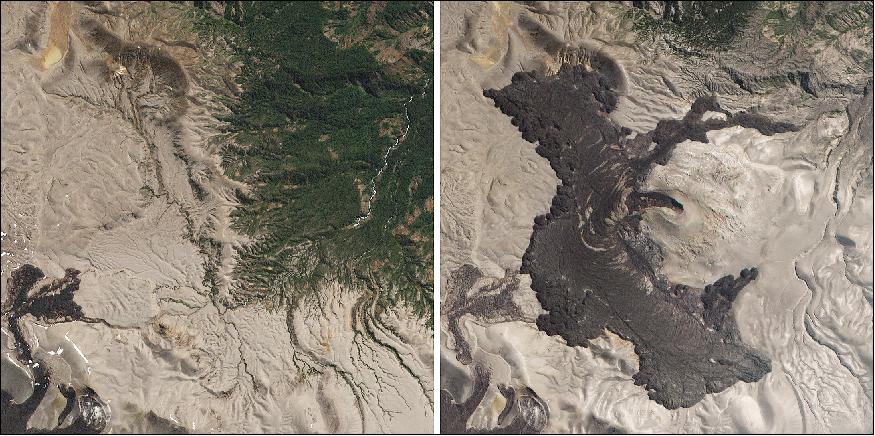
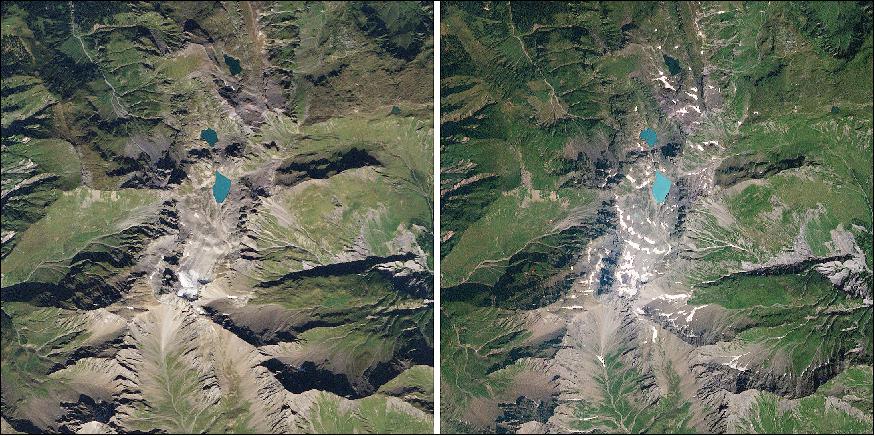
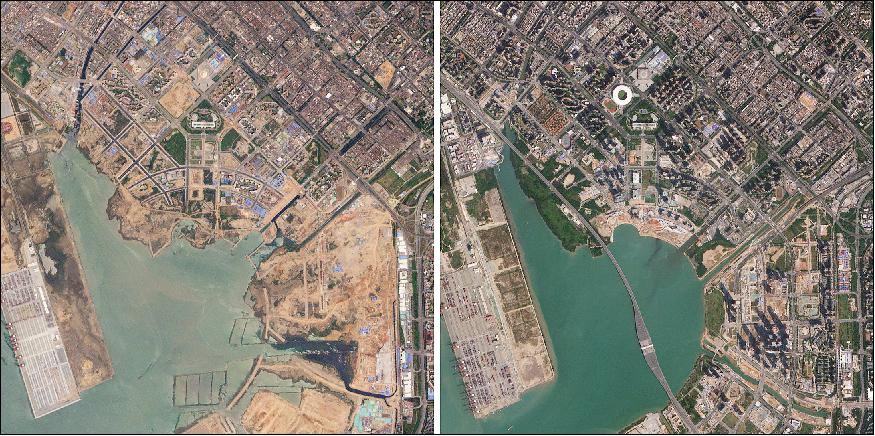
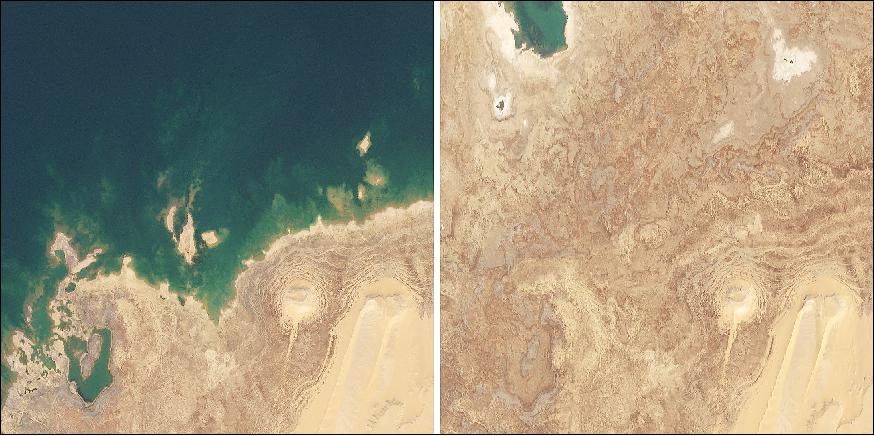
Figure 20: Since filling in the late 1990s, the Toshka Lakes in southern Egypt have fluctuated wildly due to changes in rainfall over the Nile River Watershed. These changes are visible in complex fossil shorelines in the dry lake-bed. These RapidEye images show the changes in one of the lakes from January 9, 2011 to February 28, 2019 (image credit: 2011 and 2019, Planet Labs Inc. All Rights Reserved)
RapidEye constellation 10 years on orbit 23) 24)
• August 29, 2018: The RapidEye Constellation of 5 SSTL-built Earth Observation satellite were launched into a 630 km LEO (Low Earth Orbit) on a Dnepr launch vehicle from Baikonur in Kazakhstan on 29 August 2008. The satellites were designed and manufactured for RapidEye AG, a German geospatial organization, but the constellation was subsequently sold to BlackBridge and is now owned and operated by Planet Labs. 23)
- Each of the 5 satellites has a mass of 153 kg and carries identical sensors imaging in 6.5 m GSD, and they travel on the same orbital plane, equally phased.
- Over the 10 years of in orbit operations the RapidEye constellation has captured billions of square kilometers of data, providing one of the largest daily revisit commercial satellite imagery datasets in the world. The high quality data is used for agriculture, infrastructure and environmental & social studies.
- We will be celebrating the achievements of our work-horse small satellites with the obligatory cake here - many of the staff who worked on RapidEye are still working at SSTL and have some great stories to tell about this challenging, but rewarding, project!
• August 29, 2018: Early in the morning on August 28, 2008, in the middle of the desert in Kazakhstan, five RapidEye small satellites launched into orbit aboard a Dnepr rocket. Today, we are celebrating the 10th anniversary of that momentous launch – a feat that opened a new era of Earth observation. 24)
- While today people may grasp that there are hundreds of small satellites orbiting the Earth taking pictures of our planet, it's incredible to think that just ten years ago, the concept of small satellites was largely unproven and unknown.
- Traditional satellites, about the size of a large truck, were capable of imaging the Earth at medium- to low-resolution about once every five to 10 days. RapidEye satellites, about the size of small dishwasher and weighing only 150 kg, were capable of imaging places on Earth on a daily basis. The RapidEye constellation truly blazed the trail for Planet's daily monitoring mission.
- When Planet acquired the RapidEye constellation in 2015, we gained access to a rich archive of six years of global imagery – six billion square kilometers at 5-meter resolution – allowing us to bring one of the largest commercial satellite imagery datasets to the web.
- Although originally designed for a lifetime of seven years, the RapidEye constellation has been operational over the past 10 years without interruption. Here are just a few interesting facts from the constellation over its lifetime:
a) RapidEye satellites have orbited the Earth more than 270,000 times
b) RapidEye satellites have traveled a distance of nearly 12,490,000,000 kilometers – which is over 85 times the distance between the Earth and the sun.
c) The RapidEye constellation has taken more than 660,000 pictures of Earth's total landmass, which is equal to more than 15 billion square kilometers of imagery data.
Happy 10th birthday and cheers to our RapidEye constellation for their faithful service in our mission to make global change visible, accessible, and actionable!
• April 2017: Planet operates the PlanetScope (PS) and RapidEye (RE) Earth-imaging constellations. Imagery is collected and processed in a variety of formats to serve different use cases, be it mapping, deep learning, disaster response, precision agriculture, or simple temporal image analytics to create rich information products. 25)
- The RapidEye satellite constellation is operational (9th year on orbit) - consisting of five satellites collectively able to collect over 6 million km2 of data per day at 6.5 m GSD (at nadir). Each satellite measures less than one cubic meter with a mass of 150 kg (bus + payload). All five satellites are equipped with identical sensors and are located in the same orbital plane.
- RapidEye imagery products are available in two different processing levels to be directly applicable to customer needs.
Product Name | Description | Product Level |
RapidEye Basic Scene Product | Radiometric and sensor corrections applied to the data. | Level 1B |
RapidEye Ortho Tile Product | Radiometric and sensor corrections applied to the data. | Level 3A |
- The RapidEye Basic product is the least processed of the available RapidEye imagery products. This product is designed for customers with advanced image processing capabilities and a desire to geometrically correct the product themselves. This product line will be available in GeoTIFF and NITF formats.
- The RapidEye Basic Scene product is radiometrically- and sensor-corrected, providing imagery as seen from the spacecraft without correction for any geometric distortions inherent in the imaging process, and is not mapped to a cartographic projection. The imagery data is accompanied by all spacecraft telemetry necessary for the processing of the data into a geo-corrected form, or when matched with a stereo pair, for the generation of digital elevation data. Resolution of the images is 6.5 m GSD at nadir. The images are resampled to a coordinate system defined by an idealized basic camera model for band alignment.
• January 2016: In the meantime, Planet Labs changed its name to Planet. A RapidEye product specification catalog is provided. 26)
• October 29, 2015: BlackBridge, a Planet Labs company, is the leading partner of the project ForMoSa (Forest Degradation Monitoring with Satellite Data), an Innovator III project funded by ESA (European Space Agency) through the Data User Element. The project aims at developing methodologies for forest degradation monitoring and algorithms for sensor interoperability in the frame of REDD+ MRV (Reducing Emissions from Deforestation and forest Degradation+Measurement, Reporting and Verification). These are considered as high-priority research topics by the GFOI (Global Forest Observation Initiative). 27)
- For this project, BlackBridge has teamed up with Wageningen University and FAO (Food and Agriculture Organization of the UN), two world-class organizations with an active involvement in REDD+. Wageningen University provides scientific support for the development of novel approaches for deforestation and forest degradation monitoring, whereas FAO's role in this project is to validate the outcome methodologies and results from the test sites in Peru, Vietnam, and Ethiopia.
• October 15, 2015: The acquisition of BlackBridge by Planet Labs is now complete. Our energy is now focused on going to market as one team, under a common brand and executing a single global strategy. Over the coming months we'll role out incremental changes, which will improve our product offerings, service levels and empower our partners and customers to do even more. 28)
• July 15, 2015: BlackBridge announced today that it has entered into a definitive agreement with Planet Labs to acquire the RapidEye suite of core offerings. Planet Labs is provider of a dataset of satellite imagery based in San Francisco, California, that designs, builds, and operates a fleet of Earth imaging satellites. 29)
- This is the next step toward achieving BlackBridge's mission to explore the Earth to empower decisions, which aligns perfectly with Planet Labs' mission. For years, BlackBridge has served customers across a broad range of domains, but has fundamentally focused on agriculture, energy & infrastructure, consumer mapping, government, business intelligence, environmental & social impact. The result of this union with Planet Labs is expected to increase the value BlackBridge provides to existing customers and provide the means to expand into new domains.
- The company is expected to operate largely as it does today. It is anticipated that customers will continue to experience the exceptional service they've come to expect from BlackBridge and will soon see the benefits of this new alliance.
- The transaction is subject to the customary closing conditions and is expected to close during the third quarter of 2015.
• June 2, 2015: BlackBridge announced today that it has entered into a sole distribution agreement with EarthSTAR Inc. to provide RapidEye imagery and solutions in the People's Republic of China, including Hong Kong and Macao. EarthSTAR Inc., a subsidiary of EarthView Image Inc. based in Beijing, is expanding the market in China for earth-observation satellite technologies. EarthSTAR dedicates itself to research and development of advanced technology in order to provide high-end professional information products and application services to users, with a particular focus on government agencies and organizations. 30)
• RapidEye life expectancy, May 2015: After 6 years of operations, the constellation is fully functional and will deliver the full image performance for another 5 or more operational yearsAccording to BlackBridge assessments, the RapidEye constellation will meet its mission performance requirements and continue operating through 2020 with a high degree of probability. 31)
• May 6, 2015: BlackBridge announced that it has entered into an agreement with The Climate Corporation to provide RapidEye imagery of the major agricultural areas across the U.S. for use in The Climate Corporation's products and services for farmers. 32)
- This imagery is part of the BlackBridge Monitoring Program for Agriculture that has been running in North America since 2013. BlackBridge uses the RapidEye constellation of five identical satellites to regularly collect high-resolution imagery over the major North American agricultural areas throughout the growing season. The Climate Corporation uses this imagery, along with imagery from previous seasons, to extract in-season and historical field information for farmers to evaluate crop health and identify issues before they impact yield.
• April 14, 2015: BlackBridge has just completed the production and implementation of the most current and consistent global control point database on the market, Global Reference 2.0. This will significantly improve the positional accuracy of RapidEye imagery. 33)
- BlackBridge's extensive testing and experience processing thousands of ortho-images on a daily basis confirm that Global Reference 2.0 improves positional accuracy of orthorectified imagery to under 10 m RMSE (Root Mean Square Error) on a global scale, with 80% under 7 m RMSE. This level of positional accuracy applies to ortho-products for every region of the world. Users of RapidEye products across the globe are already noticing the difference in the accuracy of their datasets and improvements to their workflows.
- In March 2015, BlackBridge introduced FarmLogs Advantage, a new version of FarmLogs that utilizes this satellite imagery data to help the users better understand crop health and performance. Through the partnership, FarmLogs will leverage BlackBridge's Monitoring Program for Agriculture over the U.S., with access to 5 m, multispectral RapidEye satellite imagery collected on a frequent basis throughout the growing season, as well as more than six years of historical imagery. FarmLogs will then extract and analyze crop-relevant information to help farmers maximize productivity and field profitability.
• March 1, 2015: BlackBridge Geomatics is now distributing 30 cm color imagery from DigitalGlobe's new WorldView-3 satellite. This is the highest resolution ever available from a commercial satellite platform, and opens a number of new possibilities in satellite-based mapping, planning and analysis. With the help of DigitalGlobe, BlackBridge can now offer precision 30 cm color imagery to all its customers, any time, and for any place on Earth. 34)
• October 2014: The design lifetime of each of the satellites within the RapidEye constellation is 7.25 years following launch. It was determined pre-launch by the consumption rate of relevant consumables as well as by time dependent functionalities within distinct subsystems. Within the five years of operations, all subsystems were closely monitored to predict the actual operational lifetime of the satellites. 35)
- The consumption rate of the propellant is and has always been considerably lower than assumed during the design phase. The current fuel level along with the predicted fuel use based on the current orbit maneuvering strategy shows that the propellant will not be a limiting factor for the constellation within the next 30 years.
- Assessing telemetry data over the last five years has allowed the refinement of the battery fade model to better predict the fade behavior. It shows that the batteries will still support nominal operations after 2020. Currently, the solar cells generate enough power for both imaging operations and to charge the batteries to their full capacity. Also, there is additional margin above the current needs for charging capability.
- Up to this point in time there are no "stuck" or "dead" pixels in any of the RapidEye payloads and ground based algorithmic approaches are available to mitigate the risk of such occurrences. Furthermore, all satellites can perform full roll maneuvers (±20º) in order to maintain the constellation daily revisit requirement.
- On user request, RapidEye extended their system reception capability to allow direct reception of image data. This RapidEye Direct Access service provides users the capability to directly receive image data from the satellite constellation to their own system.
- A collision avoidance capability was established, which allows a consistent monitoring of and an instant reaction to objects (such as space debris or other satellites) on the RapidEye orbit, which expose an increased collision probability. 36)
• May 15, 2014: Following its commitment to provide continuity to the existing RapidEye constellation, today BlackBridge has released the details of the RapidEye+ constellation concept at its ENABLE 2014 Partner Conference. RapidEye+ will be a constellation of five satellites with an imaging capacity that will far exceed the current RapidEye constellation's capacity of 5 million km2 per day. 37)
- The RapidEye+ superspectral system will include 14 bands strategically placed for applications in agriculture, vegetation monitoring, land cover discrimination, water quality, and many others. This band set also includes a panchromatic channel with resolution better than 1 meter. RapidEye+ is expected to launch in 2019, allowing significant overlap with operation of the current RapidEye constellation. 38)
• March 2014: BlackBridge has taken over the operations of RESA (RapidEye Science Archive), pursuant to an agreement with DLR (German Aerospace Center). 39) The project is funded by the German Ministry of Economic Affairs and Energy (BMWi). RESA was initially operated by DLR/DFD (Remote Sensing Data Center), aiming at supporting scientific research projects within Germany by providing RapidEye imagery free of charge. Since 2009, the RESA program has allowed Germany-based scientists to benefit from BlackBridge's RapidEye archive, which currently holds more than 5 billion km2 of 5 m imagery. 40)
• The RapidEye constellation spacecraft and their payloads are operating nominally in 2014. In August 2013, the constellation was 5 years on orbit. 41)
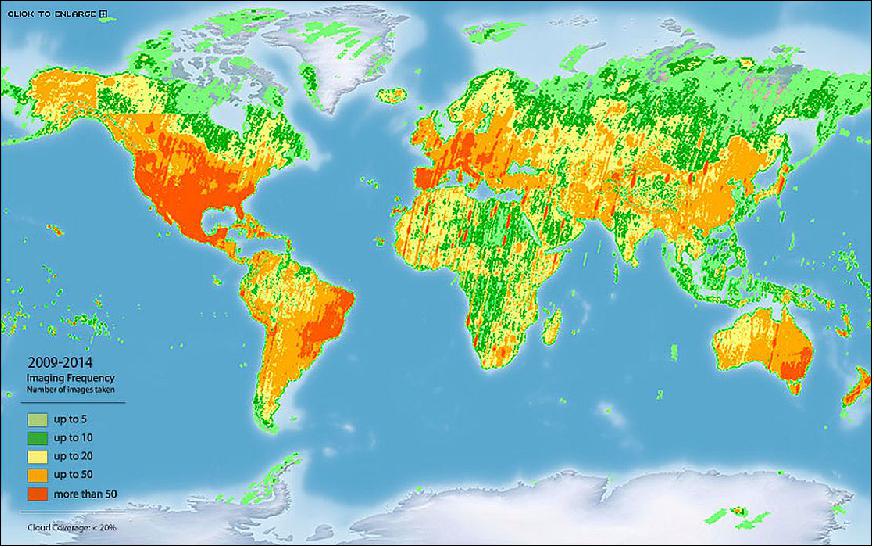
• The constellation is adding ~ 1 billion km2/year of imagery into their archives. This corresponds to about seven times the Earth's land surface/year. Subsequently, potential AOIs (Areas of Interest) are not only covered once, but with a high temporal resolution. Figure 21 summarizes the imaging frequency of archived data. The Earth's populated land mass is covered multiple times. 43)
• BlackBridge undertook serious efforts to adapt to changing market and boundary conditions. The capabilities of the constellation have evolved and continue to evolve. To keep up with evolving market demands, BlackBridge has continually worked at enhancing the mission concept beyond its original vision and capabilities, extending the mission concept to include data sales, and emergency response.
• In 2013/2014, BlackBridge is studying and evaluating the requirements for data continuity, allowing the seamless provision of RapidEye data to the community beyond the lifetime of the current satellite system.
• Nov. 20, 2013: As part of their long-standing relationship, BlackBridge AG has provided ESA ( European Space Agency) with a substantial time series of RapidEye imagery to support the Sentinel-2 preparatory project. The aim was to collect imagery at the same time frequency Sentinel-2 will, as well as support the R&D activities relevant to the Sentinel-2 mission (e.g. agriculture, wetlands, coastal, food security and forest monitoring). RapidEye imagery was selected by ESA because of its spatial resolution and revisit capabilities. 44)
• Sept. 30, 2013: RapidEye announced today that its North American agricultural imaging campaign has been completed successfully. The campaign, which ran monthly from May 15, 2013 through September 14, 2013, generated more than 16 million km2 of cloud-free imagery over 3 million km2 spanning twenty-eight US states and three Canadian provinces. 45)
• May 2013: RapidEye starts the 2013 North American Agricultural Imaging Campaign, to be imaged four times over four months. This is the second year for the campaign, which will task 2.9 million km2 covering most major agricultural areas in the US, including the ‘corn belt', and Canada. The entire campaign, which runs through September 15, will cover these areas once each month, producing over 11.5 million km2 of imagery for agricultural monitoring. 46)
The customer base for this campaign are basically agronomy/agriculture companies providing value-added products to their customers (mostly farmers). 47)
• April 2013: All 5 satellites are fully-operational. Engineers and operators monitor systems trends and performance routinely. Improved calibration techniques developed to ensure image quality uniformity and stability. The space segment is utilized beyond initial design capacity. 48) 49)
- The original design of the RapidEye system aimed for a collection capacity of 4 million km2/ day and a processing capacity of around 2.1 million km2/day. At the start of operations in 2009, the initial capacity was about 3 million km2 per day. Steady improvements have augmented the collection capacity of the constellation to be able to now (2013) collect up to 5 million km2/ day. Among other measures, RapidEye applies seasonal data compression settings to optimize the usage of the on-board data storage capacity, keeping image quality at the highest standard.
- The power consumption of the constellation has turned out to be lower than initially estimated during the satellite design phase. A lower power consumption rate allows data to be acquired during more orbits, without the need for rest orbits. The original limitation of 10 imaging orbits per day has now been extended to 12 - 13 imaging orbits per day without compromising the battery charge-discharge lifetime performance. This extends the capabilities of each satellite and results in a larger cumulative amount of acquired data (Ref. 49).
- As of early April, 2013, RapidEye has an increased data downlink capacity through greater access to KSAT's larger antenna network in Svalbard, Norway. These larger strategically placed Northern antennae offer RapidEye the ability to provide more reliable continuous data collection around the globe,particularly in Australia and the Far East.- In addition, RapidEye has recently upgraded its existing dedicated KSAT antenna with S-band capability to support TT&C contact with the constellation. The improved communication service allows RapidEye contact with the spacecraft on every orbit, which allows for more agile response and better maintenance of the satellites' health and lifespan. 50)
• In January 2013, the RapidEye constellation is over 4 years on orbit and continues to operate effectively, with all five satellites fully operational. Based on the current performance of the satellites and the abundance of consumables such as propellant and power, RapidEye now expects the constellation to perform into 2019 or later. 51)
- As of mid-December 2012, RapidEye AG relocated its HQs from Brandenburg an der Havel (~ 80 southwest of Berlin) to the city of Berlin. The spacecraft control center is located in Berlin, and the S-band and X-band downlink stations are located in Svalbard, Norway.
• In November 2012, BlackBridge joined the ESA TPM (Third Party Mission) program. Through this program, ESA provides data to the European and international scientific user community, as well as to supplement its own internal projects for application development and research. RapidEye's archive data is now available to the scientific user community from ESA member states (including Canada), the European Commission Member States, as well as Africa and China (as part of the Dragon program) through project proposal submission via the RapidEye information area on ESA's Earthnet Online Portal. 52)
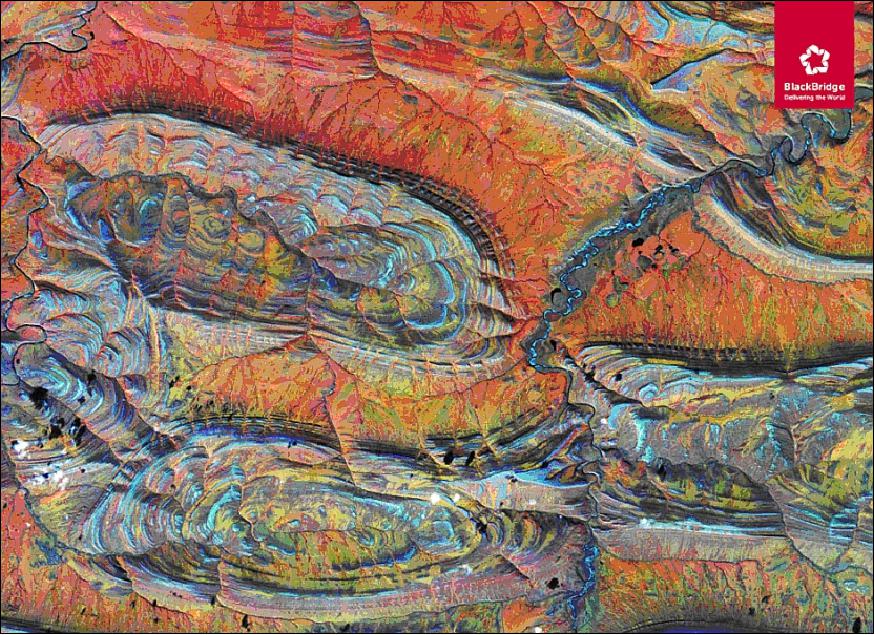
• On August 29, 2012, the constellation was four years on orbit.
• Summer 2012: All 5 spacecraft of the constellation are operating nominally. 53)
- A healthy power margin allows to drive the constellation almost to its imaging capacity
- Cameras are well calibrated: Relative calibration shows that all 5 cameras are well within ± 1% of each other
- Absolute calibration indicates accuracy within 6%
- Based on the current status of the consumables, the lifetime could extend until 2020.
• The RapidEye constellation is operating nominally in 2012.

• In December 2011, RapidEye was awarded a contract from China's Ministry of Land and Resources (MLR) to cover almost five million square kilometers of China over the next few months. This represents the third consecutive year that RapidEye was a successful bidder to cover China for the MLR. 54)
• In September 2011, RapidEye was awarded an Indefinite Delivery Indefinite Quantity (IDIQ) contract with NGA (National Geospatial-Intelligence Agency) of Washington D.C. 55)
• The RapidEye constellation is operating nominally in 2011. Two years of operational service have proven RapidEye's capability to react fast and efficiently to varying customer requests. 56)
- BlackBridge undertook serious efforts to adapt to changing market and boundary conditions. The capabilities of the constellation have evolved and continue to evolve. To keep up with evolving market demands, RapidEye has continually worked at enhancing the mission concept beyond its original vision and capabilities, extending the mission concept to include data sales, and emergency response. The service of direct downlink capabilities to customer stations will be added in 2011 -corresponding studies were conducted in 2010 (Ref. 56).
- Since becoming operational in February 2009, RapidEye acquired and archived imagery of more than 1.7 billion km2 of the Earth's surface, among them 1.3 billion km2 with cloud cover below 20% (about 10 times the area of the solid globe). 57)
- To provide the highest quality data products possible, the space and ground segments are constantly being monitored and fine-tuned, including extensive calibration and validation campaigns. 58) 59) 60)
• The RapidEye constellation is operating nominally in 2010. In August 2010, the constellation was two years in orbit. 61)
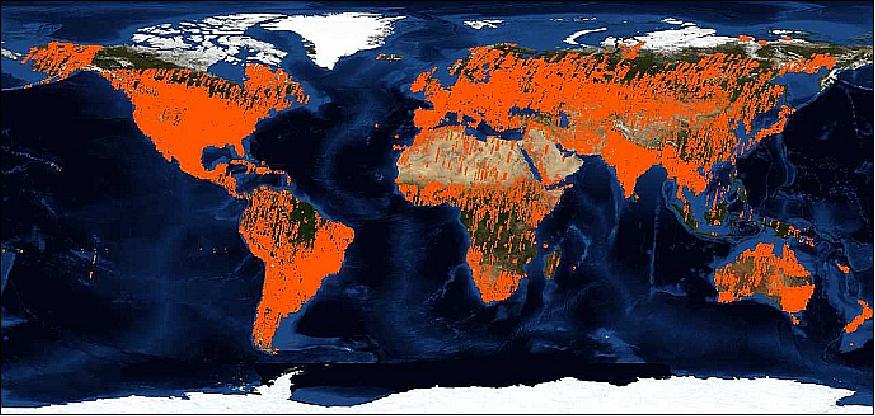
• On February 27, 2010 a heavy 8.8 magnitude earthquake struck the vicinity of Concepción, Chile. The area of Concepción was hit the hardest and was the most affected area in the region hit by the quake. Immediately after the news had spread to Europe, RapidEye, now BlackBridge), imaged the area next to the epicenter of the earthquake, which covered a total area of 13,125 km2. RapidEye used its own before and after imagery of the city to record the changes that were caused by the earthquake. RapidEye delivered these images to relief organizations who were in need of the most current and reliable Earth Observation information when trying to assess where the greatest efforts should be concentrated or to evaluate the full extent of a disaster. - Fast data acquisition and analysis of the impact of earthquakes are important issues when mapping natural disasters. 62)
- Imagery of China: In March 2010, RapidEye completed a contract to image 7.8 Million km2 of the country of China, ahead of schedule. The contract between RapidEye and the Ministry of Land and Resources (MLR) for the People's Republic of China was coordinated through the Chinese distributor, Beijing Earth Observation (BEO). 63)
• On August 28, 2009, the RapidEye team celebrated its first year of the constellation in space. 64)
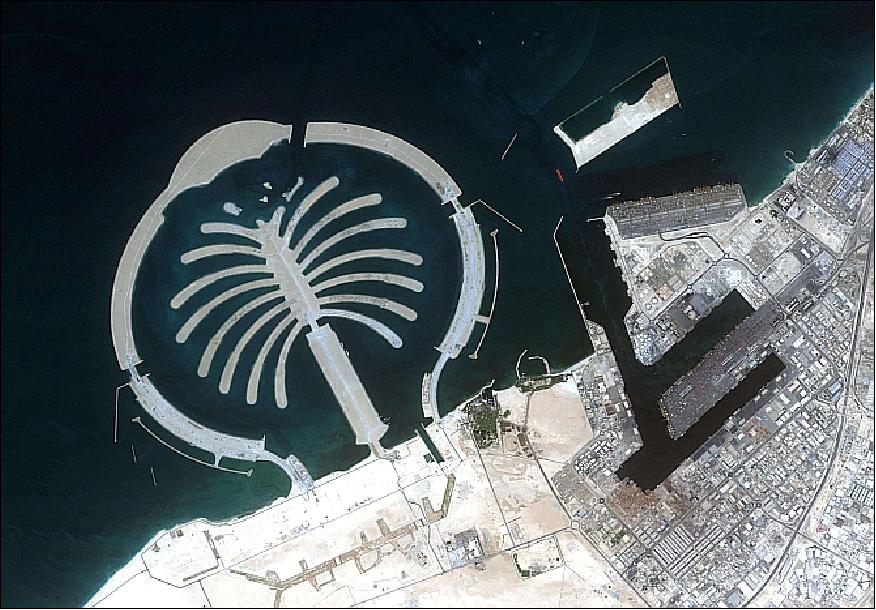
• The RapidEye constellation started nominal operations on February 4, 2009 when all testing and system calibrations were successfully completed. This opens the era of commercial provision of imagery to the global EO community. 65) 66)
• MDA handover of the system to RapidEye, now BlackBridge, in January 2009.
• As of late fall 2008, the constellation was in the commissioning phase with all spacecraft functioning as expected. The commissioning phase will take approximately 3 months until the system is expected to be ready for full operations (Ref. 2).
• SSTL is controlling the constellation throughout the two week LEOP (Launch and Early Operation Phase) in a coordinated effort between their mission control facilities in the UK and the ground station supplied to RapidEye, now BlackBridge, in Brandenburg, Germany. Commissioning will be performed from both the RapidEye ground station in Brandenburg and the SSTL mission control centre in Guildford. The 5 satellites will gradually disperse from each other following separation from the launch vehicle, allowing 3 satellites to be tracked and operated from Brandenburg with the remainder under the control of the Guildford operators. This method of operation offers the most efficient route to achieving the maximum amount of contact time per satellite during the early days of commissioning following launch. As the satellites are gradually maneuvered into position around the orbit during the commissioning phase, the Brandenburg ground station will assume full control over the constellation. 67)
• The RapidEye Newsletter of October 2008 features the first public image of the constellation (Figure 26). 68)
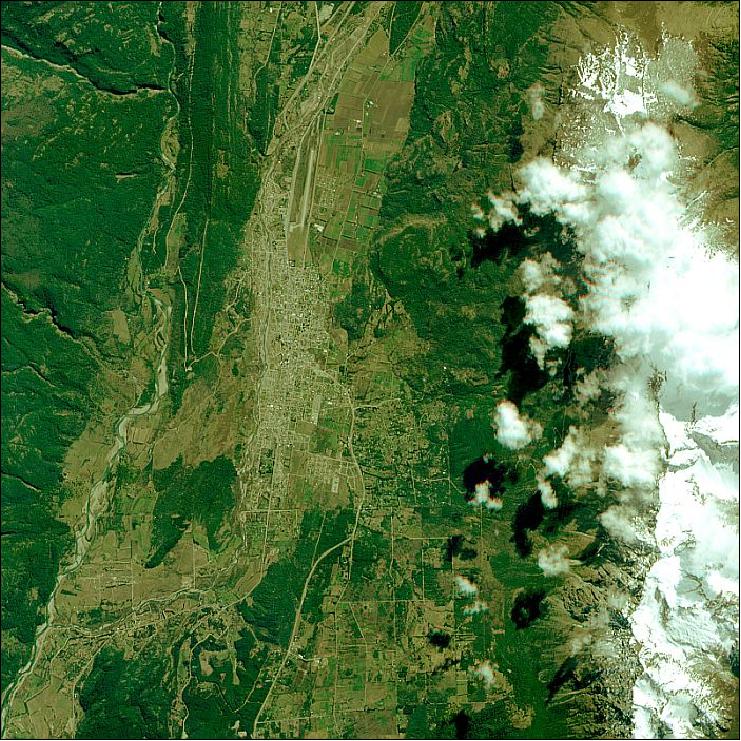
Sensor Complement (REIS)
REIS (RapidEye Earth Imaging System)
REIS is a multispectral imaging system designed and developed by JOP (Jena-Optronik GmbH), a subsidiary of the Photonics Division of Jenoptik) Jena, Germany. The instrument is also referred to as JSS-56 (Jena-Optronik Spaceborne Scanner-56) as well as MSI (Multispectral Imager) in the literature.
The collector optics utilizes a TMA (Three Mirror Anastigmatic) design - permitting generally larger FOVs (in the range of about 2-12º) than those of Cassegrain or Ritchey-Chrétien systems (FOV of about 2º max). The TMA telescope aperture diameter is 145 mm. The TMA design is based on all-aluminium telescopes. The necessary optical surface quality for applications in the visible range is achieved with ultra-precision milling and polishing techniques. The aluminium mirrors are Ni coated to achieve a suitable surface polishing quality. REIS is a pushbroom instrument which images the Earth's surface in 5 spectral bands over a swath width of 78 km (corresponding to a FOV of ± 6.75º about nadir) at a spatial resolution of 6.5 m at nadir. The collector optics image onto five parallel linear 12 k pixel CCD detectors. Filters, placed in close proximity to each CCD line array, separate the spectral imaging bands. 69) 70) 71) 72)
Band number | Band name | Spectral coverage (nm) | Center wavelength (µm) |
1 | Blue | 440-510 | 475.0 |
2 | Green | 520-590 | 555.0 |
3 | Red | 630-685 | 657.5 |
4 | Red edge | 690-730 | 710.0 |
5 | NIR (Near Infrared) | 760-850 | 805.0 |
REIS instrument mass | 43 kg (imager+ electronics box) |
Peak power consumption | 93 W (simultaneous image take & downlink) |
Instrument size | Imager: 656 mm x 361 mm x 824 mm |
Optics, aperture, f/No, focal length | TMA (Three Mirror Anastigmatic) design, 145 mm diameter, f/4.3, Effective focal length = 633 mm |
FOV | ± 6.75º about nadir, corresponding to a swath of > 70 km at an orbital altitude of 620 km |
IFOV | 6.5 m (spatial resolution), orthorectified pixel size = 5 m |
MTF (Modulation Transfer Function) | ≥ 0.25 in along-track, ≥ 0.11 in cross-track |
Detector (pushbroom type) | CCD linear array with 12 k pixels (5 arrays in parallel, 1 for each spectral band), use of triple line CCDs with 3 x 12 k pixels in a ceramics baseplate, pixel size = 6.5 µm |
Data quantization | 12 bit |
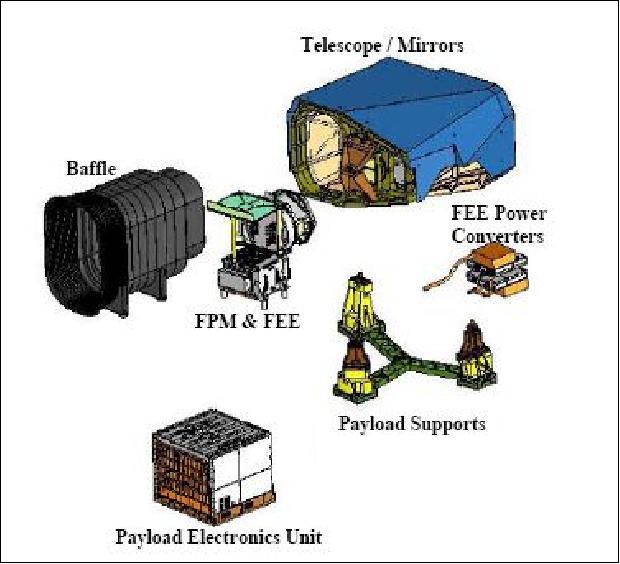
Figure 27 shows the main payload subsystems (Ref. 2):
• PEU (Payload Electronics Unit): The dedicated PEU, in close proximity to the focal plane assembly (FPA), provides support of all REIS data handling functions. For each spectral channel, a dedicated signal chain module sends the required CCD clocks and voltages, and reads out the CCD data. It includes two analog-to-digital converters (ADC digitization) for odd and even CCD video output, one FPGA, as well as data and command interfaces. The signal chains also include gain amplification and CDS (Correlated Double Sampling). Optional pixel binning is performed in the data processing and control electronics. The JSS-56 PEU design is based on technology developed by DLR in Berlin.
After digitization, the image data pass a typical processing flow comprising data compression in COU (Compression Unit), data storage in MMU (Mass Memory Unit), data formatting in DFU (Data Formatting Unit), and the downlink (Figure 32).
• Telescope and mirrors. This telescope configuration is very compact as it uses a folded optical path that has no optical obstruction so the aperture can be kept small. The telescope is an all-aluminum design that is telecentric which minimizes plate-scale changes due to residual thermal effects.
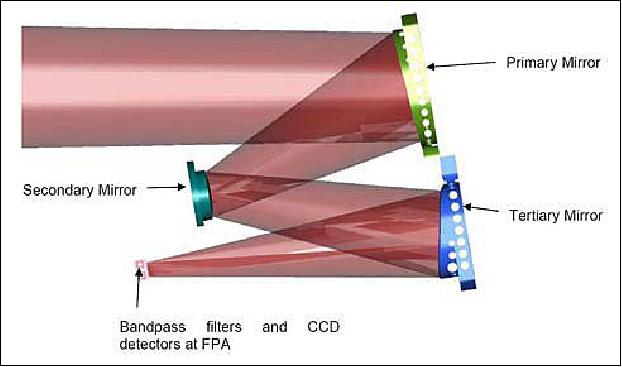
• Baffle
• FPM (Focal Plane Module): The focal plane used 2 CCD packages from e2v (France) where each package has 3 linear CCD lines. These CCD's are similar to those used for the Spot-5 program. As the payload only has 5 bands, only 2 CCD lines are used from one of the packages. Each CCD line has 12,000 pixels with a 6.5 µm square pixel pitch. There are 4 CCD outputs per line with a read-out rate of 6.5 MHz per line. The CCD dies are mounted directly to the ceramic substrate that is in the FPM. The bandpass filters are mounted directly in front of the CCD lines.
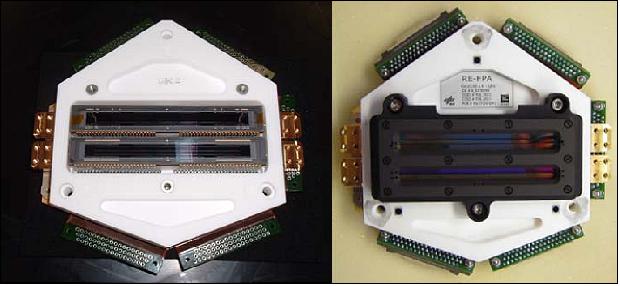
Legend to Figure 29: The left photo shows the two triple-line CCDs with 3 x 12 k pixels in a ceramic plate, the right photo shows five metal oxide interference filter stripes integrated in a filter plate are mounted directly on the FPA.
• FEE (Front End Electronics): The FEE reads out each of the CCD lines and converts the analog signals to a 12 bit digital number and sends this to the PEU. There are 5 data inputs from the FEE that correspond to each band. This data goes directly into a real-time compression unit (COU) dedicated to each channel (Figure 32). From the compression unit, the data is moved into one of 3 MMU (Mass Memory Unit) boards.
For downlink operations, the data from the mass memory is sent to the DFU (Data Formatter Unit) which performs the CCSDS formatting, Reed-Solomon encoding, and sends the data directly to the X-band downlink transmitters. The payload operation is controlled by the CIU (Control and Interface Unit) which has a CAN interface to the bus and also a PPS interface to the GPS to allow for time synchronization.
• FEE Power Convertors
• Payload supports
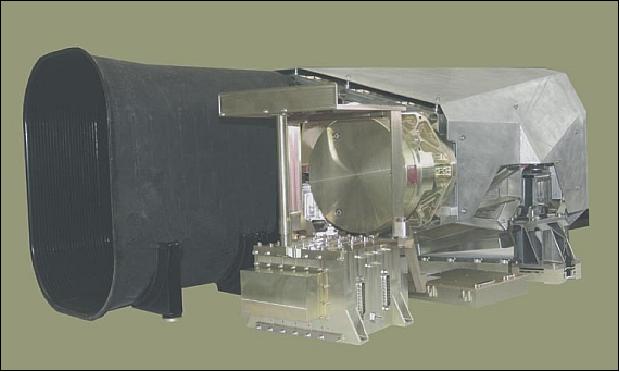
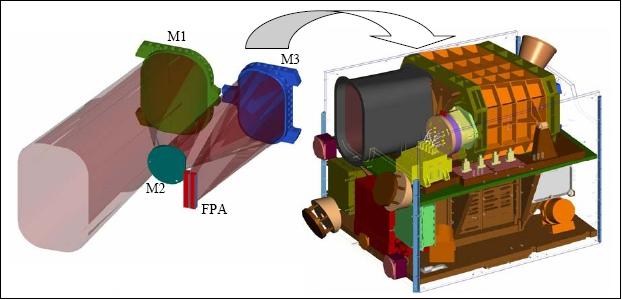
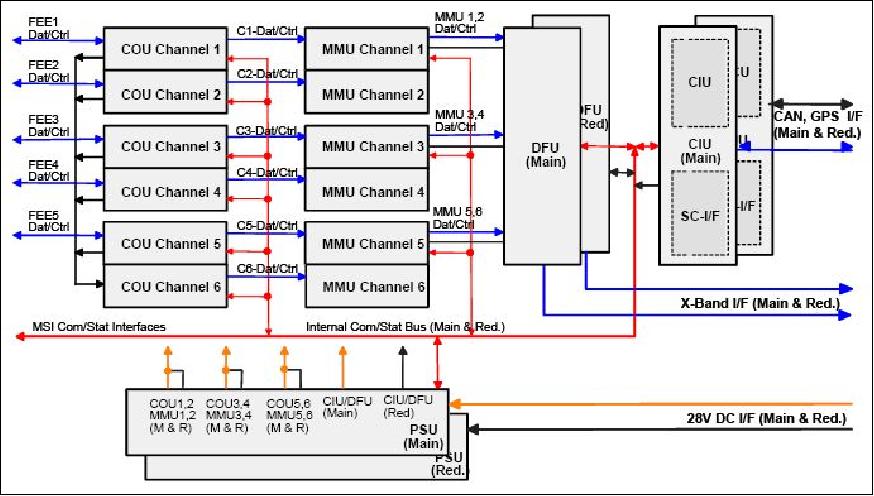
The corrected image data can be processed in a variety of ways to reduce data volume prior to transmission. Pixel binning in 2 x 2 or 3 x 3 sizes provides the most rudimentary data compression method (one axis is binned directly on the CCD to reduce readout noise). The PEU also supports both selectable lossless 2:1 compression and lossy (up to 10:1) compression ratios based upon DCT (Direct Cosine Transform) or wavelet algorithms. The compressed data, together with spacecraft GPS and attitude information, is stored in mass memory, which provides sufficient storage for a 5-band imaging scene length of up to 1200 km.
Instrument Calibration
The REIS (or MSI) instrument does not contain an on-board calibration subsystem. A preliminary in-orbit vicarious calibration campaign was performed after launch to confirm pre-launch calibration results by assessing the spatial response non-uniformity of each sensor. Over time, detector sensitivity changes require new gain and offset values to correct the banding and striping artifacts in the image data. 73)
In an effort to improve the relative spatial calibration of the pushbroom MSI and demonstrate the feasibility of an independent spatial calibration methodology, a SSM (Side Slither Maneuver) was performed with the RapidEye constellation. During SSM, the spacecraft is oriented in a 90º yaw configuration while confining the roll and pitch angle to 0º. The detector array runs parallel to the direction of motion. Thus, each pixel on the detector will be excited by the same input level of radiance as they each cover the same tightly confined target areas. Specific target areas over deserts and homogeneous snow covered region allow for effective calibration at differing levels of radiance. While roll maneuvers about the along-track direction are part of the daily imaging activities, imaging activities in non-zero yaw configurations were never foreseen by the manufacturer.
Several side-slither campaigns were performed using all of the satellites in the RapidEye constellation. Pseudo-invariant and spatially uniform terrestrial scenes that included desert and snow/ice fields were imaged with the sensor in a 90º yaw orbital configuration. In this configuration, each detector on the focal plane was positioned parallel to the ground-track direction thereby imaging the same segment of ground and exposing each detector to the same target radiance. This maneuver produced a radiometrically flat-field input to the sensor so that the relative response of each detector was determined for the same exposure level and compared to the array average.
Ideally when a side-slither image is processed, a given point on the ground is seen as a 45º line in the resultant image. This is because, a given point on the ground is sampled by a detector and is then translated over one column and down one row (in the processed image) during each successive integration period as the array moves along the target. The side-slither scanning and the resulting image formation concept are illustrated in Figure 33.
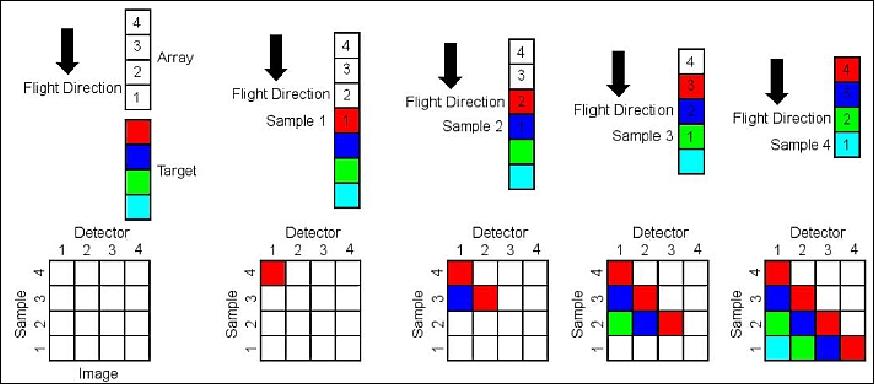
A number of Earth scene sites from North Africa were initially considered for acquiring side-slither data including the CEOS radiometric calibration sites in Libya, Algeria, and Egypt as well as the land-sea transition between Libya and the Mediterranean. The first set of side-slither data, acquired by RE5, was along a north-south line passing through Libya. These results were not promising due to scene content variations and pointing instability issues with the spacecraft that were later corrected. In addition to these sites, several regions on the Arabian Peninsula were investigated. These regions are in general uniform with minimal directional variations and were deemed suitable for side-slither imaging.
After inspecting all of the imagery from these regions, the sites over Saudi Arabia showed the most promise, and three target areas within Saudi Arabia were selected. Finally, high reflectance snow/ice regions in Greenland and Antarctica were also chosen. These sites produce radiance values that span the mid-to-high radiance portion of the MSI dynamic range. The Greenland and Antarctica sites are more uniform and excite the sensor at a higher radiance level than the Saudi Arabia sites and are therefore more desirable targets. By choosing sites in both Greenland and Antarctica, access is available to these preferable sites for most of the year, but for the few months out the year, where neither target is adequately illuminated, Saudi Arabia fills in nicely. When they are available, the large size and high/low latitude of the Greenland and Antarctica sites also allow for more imaging opportunities than Saudi Arabia. Figure 34 shows the locations of the three Saudi Arabia sites, the three Greenland sites, and the Dome C target (Antarctica), using overlays from GoogleEarthTM Mapping Services.

The improvement in image quality shows that adopting the side slither calibration technique into routine operations was worth the work. All spacecraft in the RapidEye fleet perform the side slither maneuver over one target once every three months. The method has been used successfully to provide an improvement in the relative spatial calibration of remote sensing payloads and was deemed a viable adjunct approach for the RapidEye mission (Ref. 73).
Ground Segment
The RapidEye ground segment provides the following functional spectrum:
• A customer order interface capability
• Satellite data acquisition planning function that takes into account satellite constraints, weather and cloud predictions, the underlying data acquisition plan, and special image tasking requests for stereo data acquisitions and acquisition of specific targets
• Satellite monitoring and control to task the constellation and maintain its health and safety
• Image processing capability to convert raw imagery into ortho-products
• A capability to ensure the sensor performance and processing system
• An interface to the value-added information product processing facility
• A data archive for level 1B data, and level 3A data (ortho-products)
• Support to other data providers to obtain weather forecasts, cloud cover predictions, DEMs and other information.
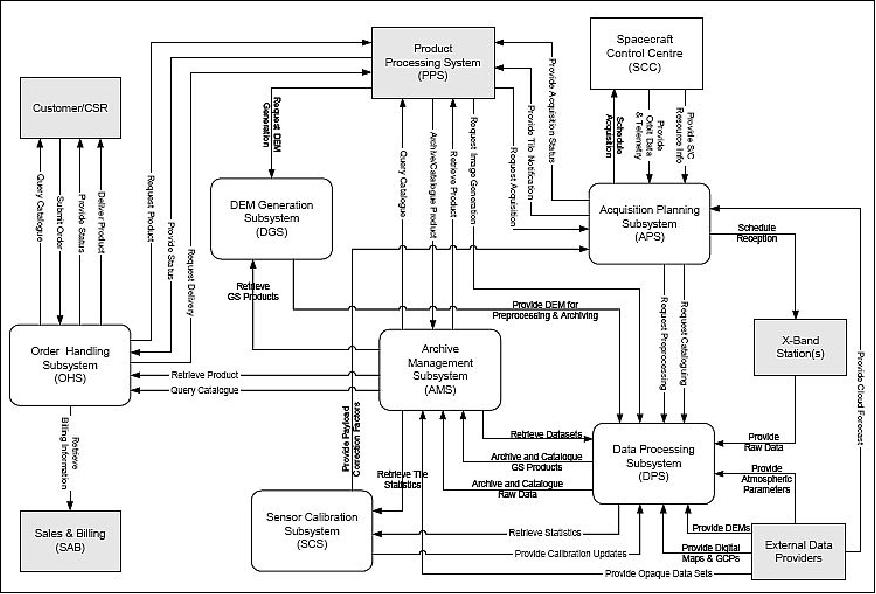
The ground segment features commercial off-the-shelf hardware and MDA proprietary software that has been selected for its performance, maintainability and expendability. The ground based equipment and facilities consist of:
• A dedicated Spacecraft Control Center to control the spacecraft constellation
• A ground segment that provides the data processing, archiving facilities and customer interfaces
• Use of commercial data downlink sites
• An interface to RapidEye's product processing facility that uses the image data from the ground segment to generate the information products needed by customers.
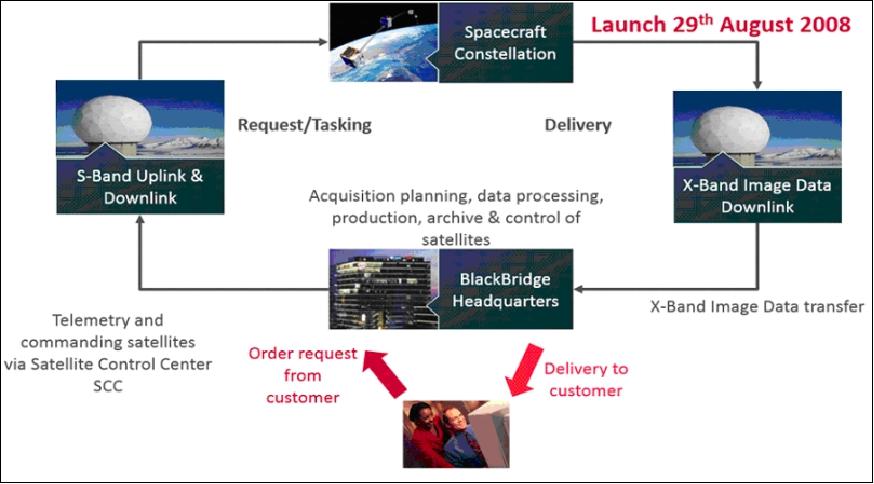
RapidEye System Architecture: RapidEye employs a dedicated SCC (Spacecraft Control Center), reception facilities for uplink and downlink services, and a ground segment designed for planning, acquiring, and processing imagery, as illustrated in Figure 37. The uplink and downlink capability are provided by reception stations located at Svalbard (Norway) and operated by Kongsberg Satellite Services (KSAT). A dedicated 9 meter antenna is used for most of the X-band passes, while a pool of larger shared antennas is used during times of the day when RapidEye makes low elevation passes over Svalbard. A dedicated communications link connects the reception facilities at Svalbard and the RapidEye ground segment in Berlin. After each satellite pass over Svalbard, data is sent directly to the ground segment in Berlin for processing and archiving. 74)
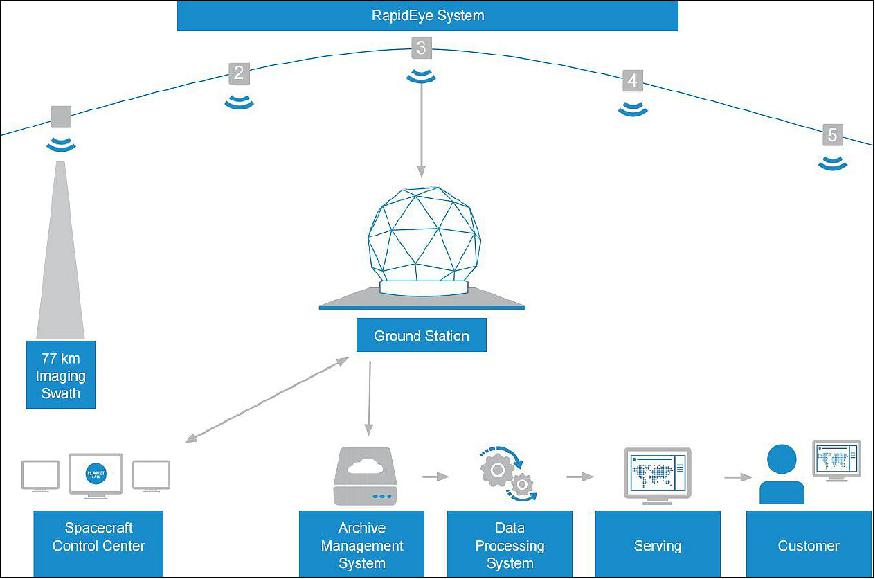
RapidEye Image Products
RapidEye image products are provided in different processing levels to be directly applicable to customer needs. The table below summarizes the various processing levels of image products. 75)
Level | Description |
1B | RapidEye Basic Product - Radiometric and sensor corrections applied to the data. On-board spacecraft attitude and ephemeris applied to the data. |
3A | RapidEye Ortho Product - Radiometric, sensor and geometric corrections applied to the data. The product accuracy depends on the quality of the ground control and DEM used. |
3B | RapidEye Ortho Take Product – extends the usability of orthorectified RapidEye products by leveraging full image takes and adjusting multiple images together to cover large areas more accurately with fewer files. |
3M | Mosaic Product. Seamless, color-balanced mosaic made up of orthorectified and bundle-adjusted 1B products. |
Downlink Analysis for RapidEye Data
BlackBridge provides end-to-end solutions across the geospatial value chain. Geospatial information services make use of the RapidEye satellite constellation consisting of five satellites, owned and operated by BlackBridge. The orbital distribution of the constellation allows for daily revisit and the acquisition of > 5 million km2 of multispectral imagery per day. 76)
BlackBridge operates this end-to-end commercial Earth observation system using a dedicated SCC (Spacecraft Control Center), reception facilities for uplink/downlink services, and a ground segment designed to plan, acquire, and process imagery. Figure 38 shows an overview of the imaging times across the globe for the RapidEye system.
The constellation consists of five satellites separated in a single sun-synchronous orbital plane of ~630 km altitude. The phase separation of the satellites is driven by an equally spaced ground track between two successive satellites. The maximum imaging length is ~1200 km.

Svalbard X-band data receiving station: RapidEye image data is downlinked via an X-band receiving station, owned and operated by KSAT (Kongsberg Satellite Services) in Svalbard, Norway. The geographical location of this reception facility, with a latitude of 78º, allows for downlinking image data on every orbit. Figure 39 shows the reception cone of the ground station antenna and the passes of the RapidEye satellite constellation during one day.
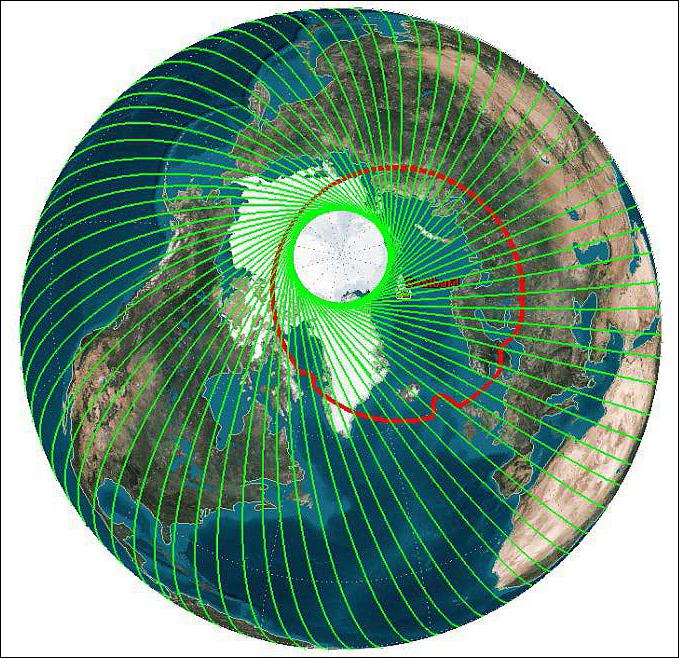
It can be seen that a certain number of passes are just at the edge of the reception cone with a very low elevation. These low elevation passes have a shorter contact duration which is illustrated in Figure 40. This figure shows the available downlink time at the reception facility in Svalbard over the day. A dip in the contact duration is visible for the time period from 0:00 to 9:00 UTC.
Image data is downlinked at the X-band receiving station in Svalbard approximately one hour after acquisition. Thus, it is possible to connect an area's imaging time window with the downlink time and to identify which locations are affected by reduced downlink capacity (Figure 40). These areas are mainly West Australia, East and Mid Asia.
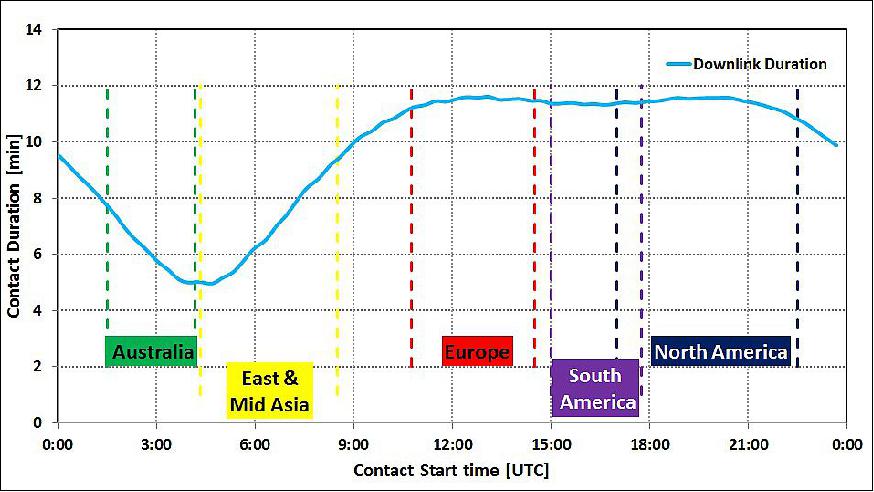
Analysis of the Ground Station Infrastructure
The downlink duration is driven by two main factors:
1) The elevation profile of a ground station with respect to the geographical location
2) The elevation at the beginning and end of a pass, furthermore referred to as AOS (Acquisition of Signal) and LOS (Loss of Signal).
The elevation profile of the RapidEye satellite constellation for Svalbard is illustrated in Figure 41. Here, the maximum elevation of a satellite pass is plotted against the contact time. The average maximum elevation depends on the geographical latitude of the reception facility and indicates the available contact time summed over a day. The minima of this curve (4:00 and 16:00 UTC) are related to the longitude of the ground station's geographical location. This effect is illustrated with two theoretical ground stations at different longitudes (green dotted line) and different latitudes (blue dotted line).
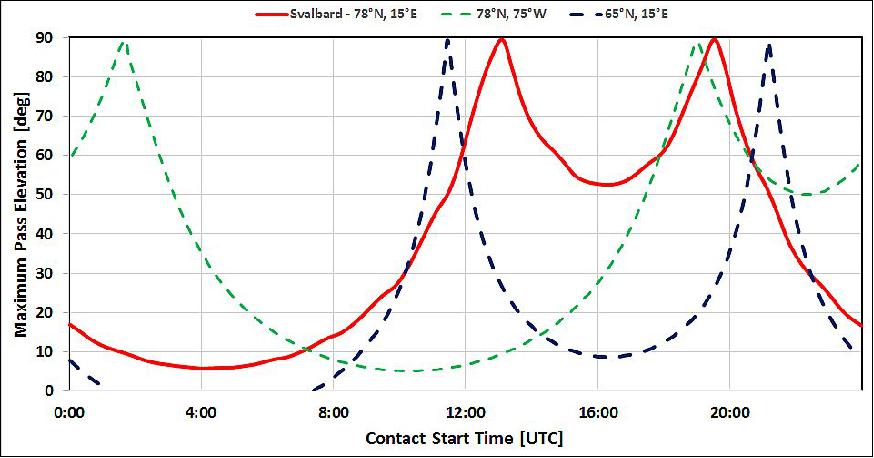
A possible solution to increase the imaging and downlink capacity for the affected areas (Asia and West Australia) would be to introduce a Data Receiving Station at a location with a significant shift in the longitude and a reasonably high latitude. For a latitude of 65°N the two theoretical ideal longitudes for this area of interest would be 116.5°W or 143°E (Figure 42), which describes a location in either Northern Canada or North-Eastern Russia.
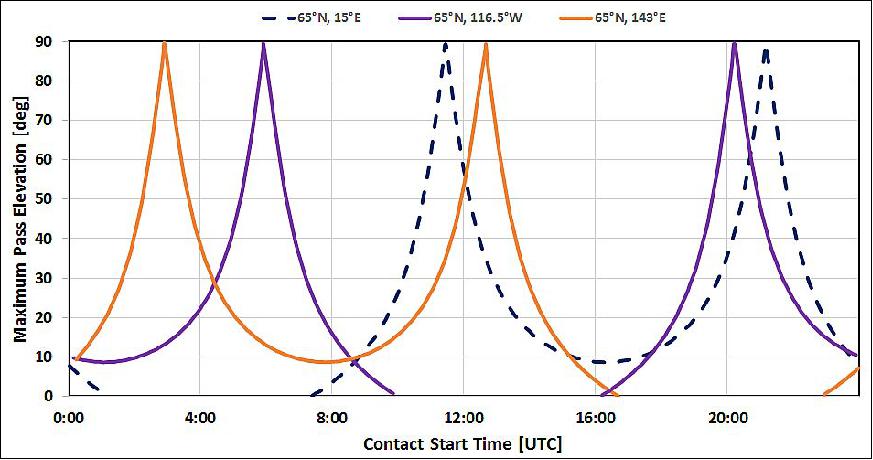
Figure 43 illustrates the effect on the downlink duration for orbits over Australia and East to Mid Asia. It shows that the longitude influences the contact start time for the maximum available downlink capacity.
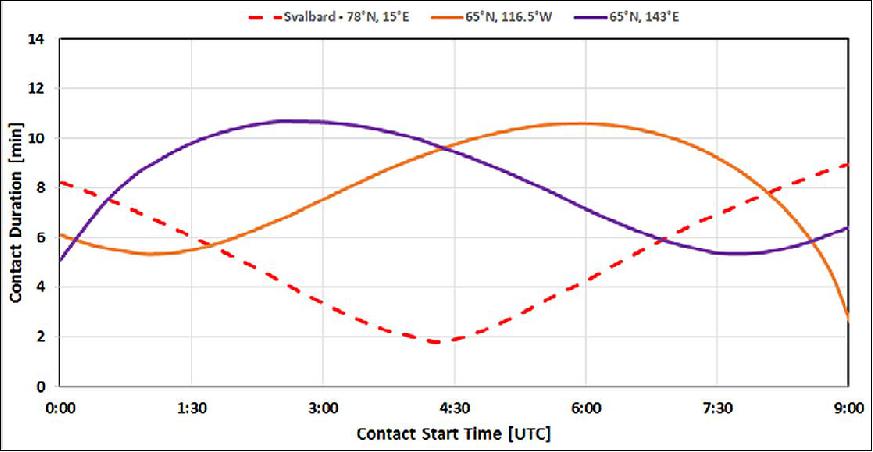
Pass elevation at AOS and LOS: The AOS and LOS of a pass is determined by the characteristics of the link between the ground station receiving antenna and the satellite transmission antennas. A longer contact duration can be achieved by starting and ending transmissions at lower elevations. However, in order to meet the necessary link margin at the lower elevations, an antenna with higher gain is required. Thus, the downlink capacity can be improved by increasing the gain of the ground station antenna. Figure 44 shows the downlink capacity increase that can be achieved by reducing the AOS elevation with a higher antenna gain on ground.
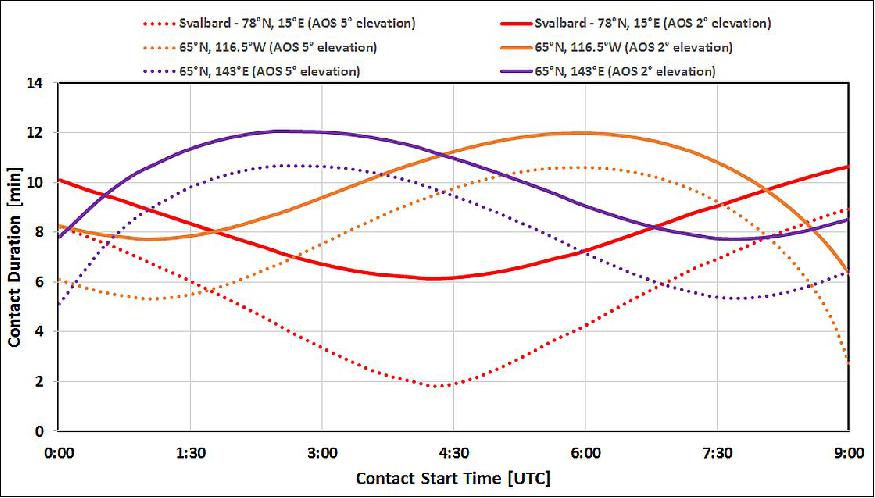
Table 6 shows the improvement possible by reducing the AOS elevation from 5º to 2º.
Parameter | Svalbard (78ºN, 15ºE) | Polar Station West (65ºN, 116.5ºW) | Polar Station East (65ºN, 143ºE) |
Average | 53.8% | 23.0% | 22.4% |
Minimum | 242.8% | 58.7% | 44.4% |
Maximum | 21.2% | 13.2% | 13.1% |
Integration of upgrades to the RapidEye system: The imaging and downlink capacity of the RapidEye constellation for the affected areas was improved by enhancing and upgrading the ground station infrastructure. For the time period between 0:00 UTC and 9:00 UTC the RapidEye constellation was granted access to a pool of several antennas with larger dish sizes. The larger antennas, with higher gain values, enable transmissions to begin at 2 degrees elevation.
Figure 45 shows the downlink time profile for the RapidEye constellation with the improved configuration at KSAT. The increased available downlink time for the areas of interest between 0:00 and 9:00 UTC is:
• Average downlink time: +18.7 %
• Minimum downlink time: +38.1 %
• Maximum downlink time: +9.9 %
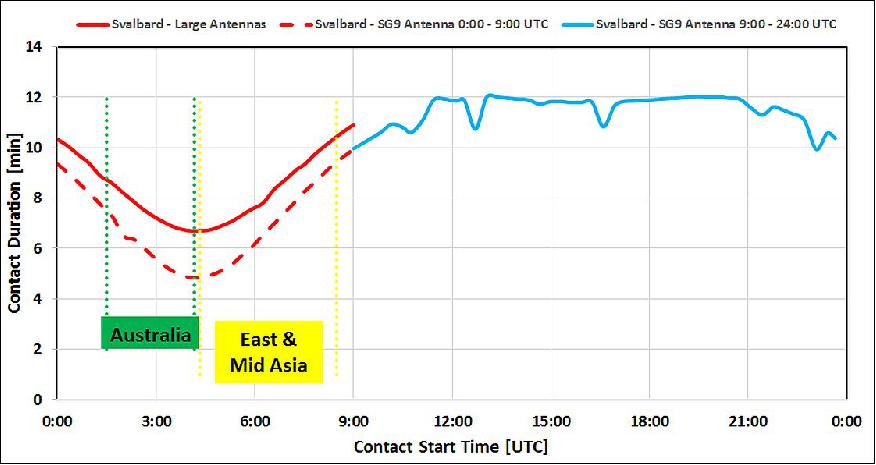
Optimal geographical location of data receiving stations for Australia and Asia: Analyses were carried out to determine the relationship between the geographical location of a Data Receiving Station and the imaging area. Figure 46 shows a selection of polar and non-polar stations which could increase the downlink capacity for images taken over Australia and East and Mid Asia. Downlinks would happen on the descending pass at the following non-polar stations: Adelaide (Australia - 34.9°S, 138.6°E), Bangkok (Thailand – 13.72°N, 100.54°E) and Mauritius (20.17°S, 57.5°E), which all lie in the Eastern hemisphere.
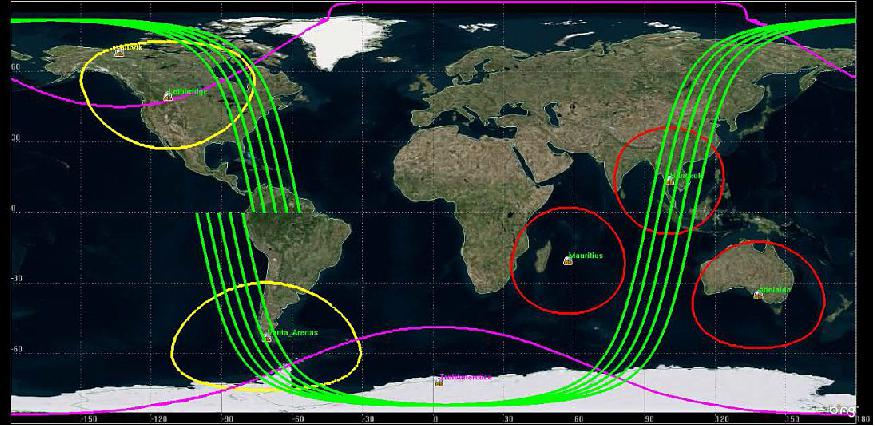
The non-polar stations in North and South America, Punta Arenas (Chile – 52.9°S, 70.9°W)) and Lethbridge (Canada – 49.7°N, 112.9°W), are on the ascending pass for downlinking imagery from Australia and Asia. Downlinks at the polar stations would start in the North (Inuvik – 68.3°N, 133.54°W) on the ascending pass and end on the descending pass; for the Southern stations (Troll/Antarctica – 72.0°S, 2.5°E), downlinks would start on the descending pass and end on the ascending pass.
Figure 47 shows the available downlink time for the non-polar station between 0:00 and 9:00 UTC. It can be seen that none of the stations cover the whole time period. This means that for an optimal downlink window, several non-polar stations would need to be chosen. For Australia, a station in Adelaide would be optimal, while for Asia a combination of Punta Arenas and Mauritius or Bangkok and Lethbridge could be a solution. The stations in Punta Arenas and Lethbridge have the drawback that they lie on the ascending pass and the required power for the downlink would then be provided only by energy stored in the satellite batteries.
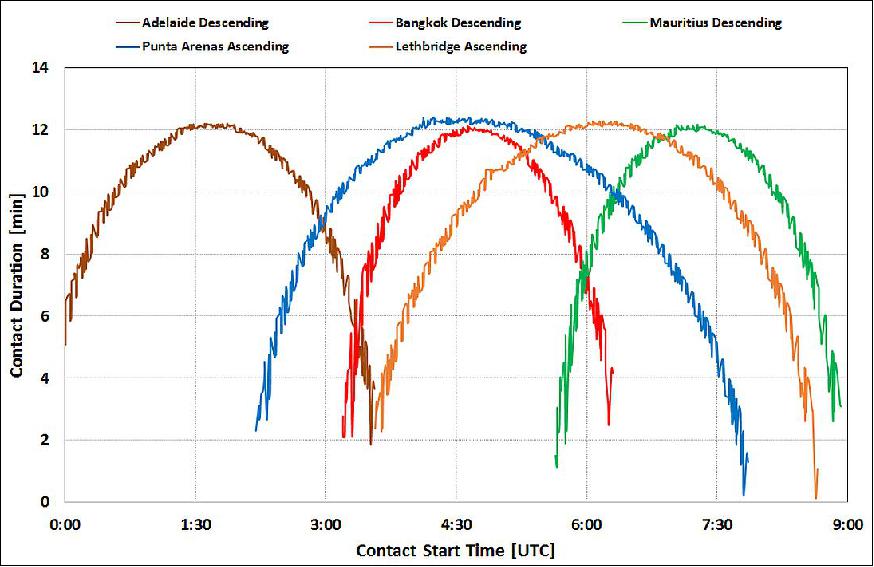
Figure 48 shows the available downlink time for polar stations between 0:00 and 9:00 UTC. Inuvik and Troll seem to be ideal for an Earth observation satellite constellation in a sun-synchronous orbit for downlinking data acquired over Australia and Asia. Both ground stations would provide an optimal downlink window for this time period.
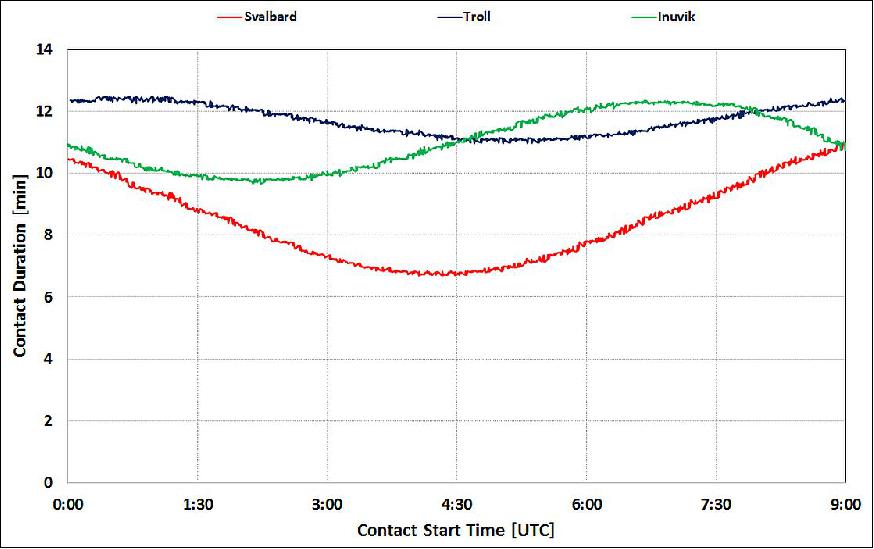
The original RapidEye design and concept of operations were focused on providing data to markets in large countries with significant agricultural industry in Europe and North and South America. Growing business in markets like East- and Mid-Asia demanded an imaging capacity increase where the link margin and available downlink capacity were at a minimum. The analysis of different geographic locations, and the upgrade of the existing ground station infrastructure at Svalbard to increase the link margin. The second solution, upgrading the existing ground station infrastructure, provided a way to increase imaging capacity in the affected markets and improve customer satisfaction quickly and reliably.
Employing larger antennas for RapidEye downlinks at Svalbard station enables better utilization of existing infrastructure. During the passes with minimum contact duration, allowing transmission to begin/end at 2 º rather than 5 º increases the contact duration from 2 minutes to 6 minutes. This provides enough imaging time to meet the customer demand over important market areas. This is also a more cost-effective solution than constructing additional ground stations.
References
1) Jonathan Gebbie, Mark Pollard, Haval Kadhem, Lee Boland, Alex da Silva Curiel, Philip Davies, Phil Palmer, Joe Steyn, George Tyc, "Spacecraft Constellation Deployment for the RapidEye Earth Observation System," Proceedings of the 60th IAC (International Astronautical Congress), Daejeon, Korea, Oct. 12-16, 2009, IAC-09.B4.3.11
2) George Tyc, Joe Steyn, Norman Hannaford, Jonathan Gebbie, Ben Stocker, Adam Baker, Michael Oxfort, "RapidEye- A cost-effective Earth Observation Constellation," Proceedings of the 59th IAC (International Astronautical Congress), Glasgow, Scotland, UK, Sept. 29 to Oct. 3, 2008, IAC-08-B4.3.03
3) G. Tyc, K. Ruthman, J. Steyn, "The RapidEye Low Cost Mission Design," Proceedings of IAC 2004, Vancouver, Canada, Oct. 4-8, 2004, IAC-04-IAA.4.11.4.02
4) G. Tyc, K. Ruthman, D. Schulten, M. Krischke, M. Oxfort, P. Stephens, A. Wicks, T. Butlin, M. Sweeting, "RapidEye - A Cost Effective Small Satellite Constellation for Commercial Remote Sensing," Proceedings of the 54th IAC, Bremen, Germany, Sept. 29 - Oct. 3, 2003
5) M. Krischke, M. Oxfort, D. Schulten, G, Tyc, "RapidEye - Business Oriented, Dedicated Earth Observation," Proceedings of 54th IAC, Bremen, Germany, Sept. 29 - Oct. 3, 2003
6) G. Tyc, J. Tulip, D. Schulten, M. Krischke, M. Oxfort, "The RapidEye Mission Design," 4th IAA Symposium on Small Satellites for Earth Observation, Berlin, Germany, April 7-11, 2003; also available in: George Tyc, John Tulip, Daniel Schulten, M. Krischke, M. Oxfort, "The RapidEye mission design," Acta Astronautica Volume 56, Issues 1-2, January 2005, pp. 213-219
7) G. Tyc, G. Buttner, M. Krischke, M. Oxfort, "The RapidEye Spacecraft," 4th IAA Symposium on Small Satellites for Earth Observation, Berlin, Germany, April 7-11, 2003, URL: http://www.dlr.de/iaa.symp/Portaldata/49/Resources/dokumente/archiv4/IAA-B4-1105P.pdf
8) M. Krischke, W. Niemeyer, et al., "RapidEye - Satellite Based Geo-Information System," IAA 2nd International Symposium on Small Satellites for Earth Observation, Berlin, April 12-16, 1999, pp. 249-252
9) Information provided by Manfred Krischke of RapidEye
11) M. Krischke, F. Jung-Rothenhäusler, D. Schulten, G. Tyc, "The New Approach Towards Commercial Earth Observation - RapidEye," 4th IAA Symposium on Small Satellites for Earth Observation, Berlin, April 7-11, 2003
12) "RapidEye and MDA Enter Partnership Agreement," SpaceRef, Oct. 2, 2002, URL: http://www.spaceref.com/news/viewpr.html?pid=9397
13) "RapidEye Mission," MacDonald Dettwiler, URL: http://www.gotomda.com/corporate/news/pr/backgrounder/RapidEye.pdf
14) "Iunctus Group Acquires Assets of RapidEye AG, New Corporate Vision More Customer Focused," Press Release of Iunctus Geomatics Corp., Sept. 1, 2011, URL: http://blackbridge.com/geomatics/uploads/2011%2009%2
001_PressRelease_Iunctus%20Acquires%20RapidEye.pdf
15) "Inctus Group Acquires Assets of RapidEye AG," Sept. 1, 2011, URL: http://www.rapideye.de/news/pr/2011-iunctuscorp.htm
16) "RapidEye is now BlackBridge," BlackBridge Press Release, Nov. 6, 2013, URL: http://www.blackbridge.com/rapideye/news/pr/2013-blackbridge.htm
17) Will Marshall, "Planet Labs To Acquire RapidEye," Planet Labs, July 15, 2015, URL: https://www.planet.com/pulse/blackbridge/
18) "BlackBridge to be Acquired by Planet Labs," BlackBridge, July 15, 2015, URL: http://blackbridge.com/rapideye/news/pr/2015-planet.html
19) Mark Pollard, "The Design, Build, Test and In-orbit Performance of Low cost Xenon Warm Gas Propulsion Systems," Proceedings of Space Propulsion 2010, San Sebastian, Spain, May 3-6, 2010
20) RapidEye Newsletter, September 2008, URL: http://www.docstoc.com/docs/4732039/Newsletter-Launch
-Edition-September-RapidEye-Launch-Successful-On-August
21) "RapidEye constellation retirement," ESA, RapidEye News, 24 January 2020 [web source no longer available]
22) Martin Van Ryswyk, "RapidEye Constellation to be Retired in 2020," Planet, 16 January 2020, URL: https://www.planet.com/pulse/rapideye-constellation-to-be-retired-in-2020/
23) "RapidEye Constellation racks up 10 years of in orbit operations," SSTL, 29 August 2018, URL: https://www.sstl.co.uk/media-hub/latest-news/2018/rapideye-constellation-racks-up-10-years-of-in-orb
24) Will Marshall, "A Toast on the 10th Anniversary of the RapidEye Constellation in Orbit," Planet, 29 August 2018, URL: https://www.planet.com/pulse/10th-anniversary-rapideye-satellites/
25) "Planet Imagery Product Specification," Planet, April 2017, URL: https://www.spaceoffice.nl/blobs/Dataportaal/Planet_Imagery_Product_Specs.pdf
26) "RadidEyeTM Imagery Product Specifications," January 2016, URL: https://web.archive.org/web/20230907004106/https://www.geoimage.com.au/wp-content/uploads/2021/06/RapidEye-Product-Specifications.pdf
27) "BlackBridge to Set the Grounds for Reliable Forest Degradation Monitoring in REDD+ MRV," BlackBridge, Oct. 29, 2015, URL: http://blackbridge.com/rapideye/news/pr/2015-REDD-Forest-Degradation.html
28) "BlackBridge is Now Part of The Planet Labs Family," BlackBridge, Oct. 15, 2015, URL: http://blackbridge.com/planet/
29) "BlackBridge to be Acquired by Planet Labs," BlackBridge, July 15, 2015, URL: http://blackbridge.com/rapideye/news/pr/2015-planet.html
30) "BlackBridge and EarthSTAR Bring RapidEye Imagery and Solutions to the People's Republic of China," BlackBridge Press Release, June 2, 2015, URL: http://blackbridge.com/rapideye/news/pr/2015-earthstar.html
31) Andreas Brunn, Cody Anderson, Taha Moufid, "Image performance trending of the RapidEye constellation after 6 years of operations," 14th JACIE (Joint Agency Commercial Imagery Evaluation) Workshop, Tampa, FL, USA, May 5-7, 2015, URL: https://calval.cr.usgs.gov/wordpress/wp-content/uploads/JACIE
2015_ABrunn__Quality-Trending-of-the-RapidEye-constellation-after.pdf
32) "BlackBridge Keeps An Eye Out With Their RapidEye For The Climate Corp. + Farmers ....E-I-E-I-O," SatNews Daily, May 7, 2015, URL: http://www.satnews.com/story.php?number=972455715
33) "BlackBridge Takes Global Positional Accuracy to a Higher Level," BlackBridge, April 14, 2015, URL: http://blackbridge.com/rapideye/news/pr/2015-blackbridge.html
34) "30 cm is Here," BlackBridge Geomatics, March 1, 2015, URL: http://www.blackbridge.com/geomatics/news/index.html
35) Enrico Stoll, Kam Shahid, "The Impact of Attitude Control System Agility on the Acquisition Capacity of Remote Sensing Constellations," Proceedings of the 65th International Astronautical Congress (IAC 2014), Toronto, Canada, Sept. 29-Oct. 3, 2014, paper: IAC-12-B6.2.6
36) Enrico Stoll, Klaus Merz , Holger Krag, Brian D'Souza, Benjamin Batisda Virgili, "Collision Probability Assessment for the RapidEye Satellite Constellation", 6th European Conference on Space Debris, Darmstadt, Germany, Feb. 22-25, 2013, URL: http://tinyurl.com/pwxgoy4
37) "BlackBridge Unveils Concept for its New Mission: Enhanced capabilities, including very high resolution and superspectral bands, will be the new benchmark for commercial earth observation," BlackBridge, May 15, 2014, URL: http://blackbridge.com/rapideye/news/pr/2014-rapideyeplus.html
38) "BlackBridge Unveils Concept for its New Mission," GEOInformatics, May 15, 2014, URL: http://www.geoinformatics.com/blog/latest-news/blackbridge-unveils-concept-for-its-new-mission
39) http://resa.blackbridge.com/
40) "BlackBridge and DLR Continue Support of German Remote Sensing Research," BlackBridge, March 4, 2014, URL: http://blackbridge.com/rapideye/news/pr/2014-resa.html
41) Information provided by Michael Oxfort of BlackBridge, Berlin, Germany.
42) Information provided by César Santos of BlackBridge
43) Enrico Stoll, Harald Konstanski, Cody Anderson, Kim Douglass, Michael Oxfort, "The RapidEye Constellation and its Data Products," Proceedings of the 2012 IEEE Aerospace Conference, Big Sky, Montana, USA, March 3-10, 2012
44) "BlackBridge Supports the European Space Agency's Sentinel-2 Mission," BlackBridge, Nov. 20, 2013, URL: http://www.blackbridge.com/rapideye/news/pr/2013-sentinel.html
45) "From the Corn Belt to Canada, RapidEye Completes Its North American Agricultural Imaging Campaign," RapidEye, Sept. 30 ,2013, URL: http://www.blackbridge.com/rapideye/news/pr/2013ag_campaign.html
46) "RapidEye kicks off 2013 North American Agricultural Imaging Campaign," RapidEye Press Release, May 13, 2013, URL: http://www.rapideye.com/news/pr/2013-agcampaign.html
47) Information provided by Claudia Hahm of RapidEye.
48) Michael Oxfort, "RapidEye Large Area Imaging Capabilities and New Countrywide Mosaic Product," 12th Annual JACIE (Joint Agency Commercial Imagery Evaluation) Workshop , St. Louis, MO, USA, April 16-18, 2013, URL: https://calval.cr.usgs.gov/wordpress/wp-content/uploads/JACIE_2013_LargeAreas_Mosaics.pdf
49) Harald Konstanski, Enrico Stoll, Brian D'Souza, Michael Oxfort, "Four years of operating RapidEye satellites - Continuous performance improvement and adaptation to customer needs and markets," Proceedings of the 9th IAA Symposium on Small Satellites for Earth Observation, Berlin, Germany, April 8-12, 2013
50) RapidEye secures enhanced data downlink support for Australia and Far-East regions," RapidEye Press Release, June 24, 2013, URL: http://www.rapideye.com/news/pr/2013-datadownlink.html
51) "RapidEye Commits to Data Continuity; discusses system health and life span," RapidEye, Jan. 17, 2013, URL: http://www.rapideye.com/news/pr/2013-1-continuity.html
52) "RapidEye joins ESA Third Party Missions Programme," ESA, Nov. 8, 2012, URL: https://earth.esa.int/web/guest/news/-/asset_publisher/G2m
U/content/rapideye-joins-esa-third-party-missions-programme
53) M. Vitale, "RapidEye Mission and Ground Segment," 3rd GSCB (Ground Segment Coordination Body) Workshop, 2012, ESA/ESRIN, Frascati, Italy, June 6-7, 2012, URL: http://earth.esa.int/gscb/papers/2012/27-RapidEye_Mission_and_Ground_Segment.pdf
54) RapidEye Contracted to cover China Third Year Running," RapidEye News Release, Dec. 7, 2011, URL: http://www.rapideye.net/news/pr/2012-china-mlr.htm
55) "NGA contract awarded to RapidEye," RapidEye News Release, Sept. 6, 2011, URL: http://www.rapideye.net/news/pr/2011-nga.htm
56) Enrico Stoll, Brian D'Souza, Harald Konstanski, Michael Oxfort, "2 Years of Operating the RapidEye Constellation – an Evolving Mission Concept and Lessons Learned," 8th IAA (International Academy of Astronautics) Symposium on Small Satellites for Earth Observation, Berlin, Germany, April 4-8, 2011; URL of presentation, IAA-B8-1504, http://media.dlr.de:8080/erez4/erez?cmd=get&src=
os/IAA/archiv8/Presentations/IAA-B8-1504.pdf
57) Horst Weichelt, Scott Douglas, Massimiliano Vitale, Frederik Jung-Rothenhäusler, "New RapidEye Image Products," 10th Annual JACIE ( Joint Agency Commercial Imagery Evaluation) Workshop, March 29-31, 2011, Boulder CO, USA URL: http://calval.cr.usgs.gov/JACIE_files/JACIE11/
Presentations/WedAM/1020_Weichelt_JACIE_11.160.pdf
58) Andreas Brunn, Denis Naughton, Horst Weichelt, Michael Thiele, Scott Douglass, Michael Oxfort, "Relative Comparison of the Spectral Resolution of RapidEye Products," JACIE (Joint Agency Commercial Imagery Evaluation) Workshop, March 29 - 31, 2011, Boulder CO, USA, URL: http://calval.cr.usgs.gov/JACIE_files/JACIE11/Presentations/WedAM/950_Brunn_JACIE_11.010.pdf
59) Denis Naughton, Andreas Brunn, Michael Thiele, "Radiometric Performance Assessment of the RapidEye Constellation_2010," JACIE ( Joint Agency Commercial Imagery Evaluation) Workshop, March 29 - 31, 2011, Boulder CO, USA URL: http://calval.cr.usgs.gov/JACIE_files/JACIE11/Presen
tations/WedAM/1005_Naughton_JACIE_11.100.pdf
60) Aparajithan Sampath, Md. Obaidul Haque, Gyanesh Chander, "Radiometric & Geometric Assessment of Data from RapidEye Constellation of Satellites," JACIE Workshop, March 29 - 31, 2011, Boulder CO, USA, URL: http://calval.cr.usgs.gov/JACIE_files/JACIE11/Posters/
11.015_Chander-Obaidul_Sampath_JACIE2011_Poster.pdf
61) "2 Years in Space: RapidEye Establishes its Place in the Geospatial Industry," RapidEye AG Press Release, Aug. 30, 2010
62) "Change Detection Services Show Damages in Areas Affected by the 2010 Chilean Quake," March 5, 2010, URL: http://www.directionsmag.com/pressreleases/rapideye146s-change-detection
-services-show-damages-in-areas-affected-by-th/120492
63) "RapidEye Has China Covered - Again and Again...," March 11, 2010, URL: http://www.amerisurv.com/content/view/7154/2/
64) "Time Flies: RapidEye Celebrates One Year In Space," RapidEye AG Press Release, Aug. 28, 2009, URL: http://www.rapideye.de/upload/Press_Releases/2009/
RapidEye_Press_Release_One_Year_Aug_28_2009.pdf
65) "With Testing Completed, RapidEye :is Open For Business," RapidEye AG Press Release, Feb. 4, 2009, URL: http://www.rapideye.de/upload/Press_Releases/
2009/RapidEye_Press_Release_Feb_04_2009.pdf
66) D. Schulten, G. Tyc, J. Steyn, N. Hannaford, M. Oxfort, P. Widmer, "RapidEye - The first six months in orbit," IAA-B7-1501, Proceedings of the 7th IAA Symposium on Small Satellites for Earth Observation, May 4-8, 2009, Berlin, Germany, URL of presentation: http://media.dlr.de:8080/erez4/erez?cmd=get&src=os/IA
A/archiv7/Presentations/1501%5FMDA%20RapidEye%20Presentation%20
May%202009%20IAA%20Conference%20Berlin.pdf
67) http://www.satnews.com/cgi-bin/story.cgi?number=435201193
68) "RapidEye satellite constellation transmits first images," DLR, October 22, 2008, URL: http://www.dlr.de/en/desktopdefault.aspx/tabid-3432/7418_read-13841/
69) Karin Schröter, "Multi-Spectral Optical Scanners for Commercial Earth Observation Missions," Proceedings of the 7th IAA Symposium on Small Satellites for Earth Observation, Berlin, Germany, May 4-7, 2009
70) F. Doengi, W. Engel, A. Pillukat, S. Kirschstein, "JSS Multispectral Imagers for Earth Observation Missions," Proceedings of the 5th IAA Symposium on Small Satellites for Earth Observation, Berlin, Germany, April 4-8, 2005
71) S. Kirschstein, A. Koch, J. Schöneich, F. Döngi, "Metal mirror TMA, telescopes of the JSS product line: design and analysis," Proceedings of the SPIE, Building European OLED Infrastructure, edited by T. P. Pearsall, J. Halls, Vol. 5962, 2005, pp. 484-493, Sept. 12-16, 2005, Jena, Germany
72) Frank Doengi, Wolfgang Engel, Alexander Pillukat, Omar Kirschstein, "JSS Multispectral Imager s for Earth Observation Missions," URL: http://www.dlr.de/iaa.symp/Portaldata/49/Resources/dokumente/archiv5/0704_Doengi.pdf
73) Godard, Enrico Stoll, Cody Anderson, Roland Schulze, Brian D'Souza, "Integrating Advanced Calibration Techniques into Routine Spacecraft Operations," Proceedings of SpaceOps 2012, The 12th International Conference on Space Operations, Stockholm, Sweden, June 11-15, 2012, URL: http://www.spaceops2012.org/proceedings/documents/id1275279-Paper-001.pdf
74) Kattia Flores Pozo, Roland Schulze, Tom Haylock, "Balancing X‐Band Image Data Reception Quality and Quantity for the RapidEye Earth Observation Mission," Proceedings of the 4S (Small Satellites, System & Services) Symposium, Valletta, Malta, May 30-June 3, 2016, URL: http://congrexprojects.com/docs/default-
source/16a02_docs/4s2016_final_proceedings.zip?sfvrsn=2
75) "RapidEye™ Imagery Product Specifications," Version 6.1, January 2016, URL: https://web.archive.org/web/20180129195725/https://www.planet.com/products/satellite-imagery/files/160625-RapidEye%20Image-Product-Specifications.pdf
76) Roland Schulze, Kam Shahid, Thomas Haylock, "Practical development of future ground infrastructure for satellite constellations," 10th IAA Symposium on Small Satellites for Earth Observation, Berlin, Germany, April 20-24, 2015, paper: IAA-B10-1310P
Spacecraft Launch Mission Status Sensor Complement Ground Segment References Back to top